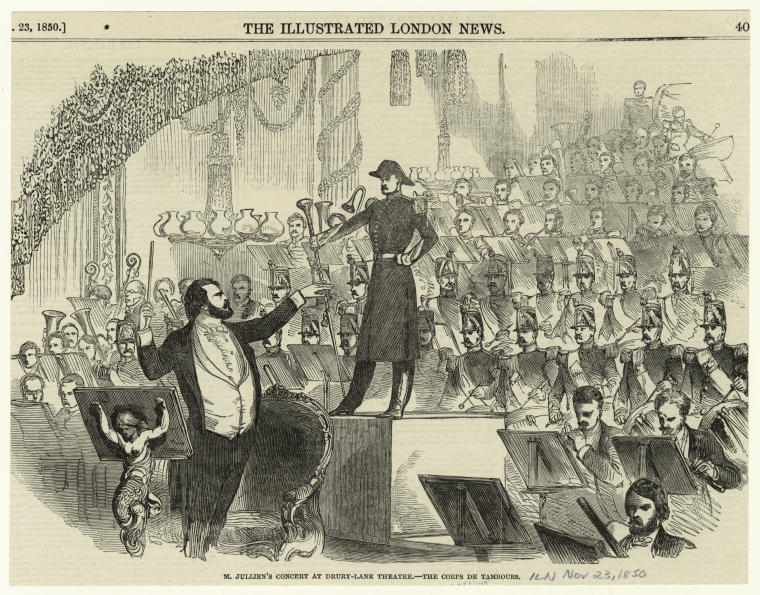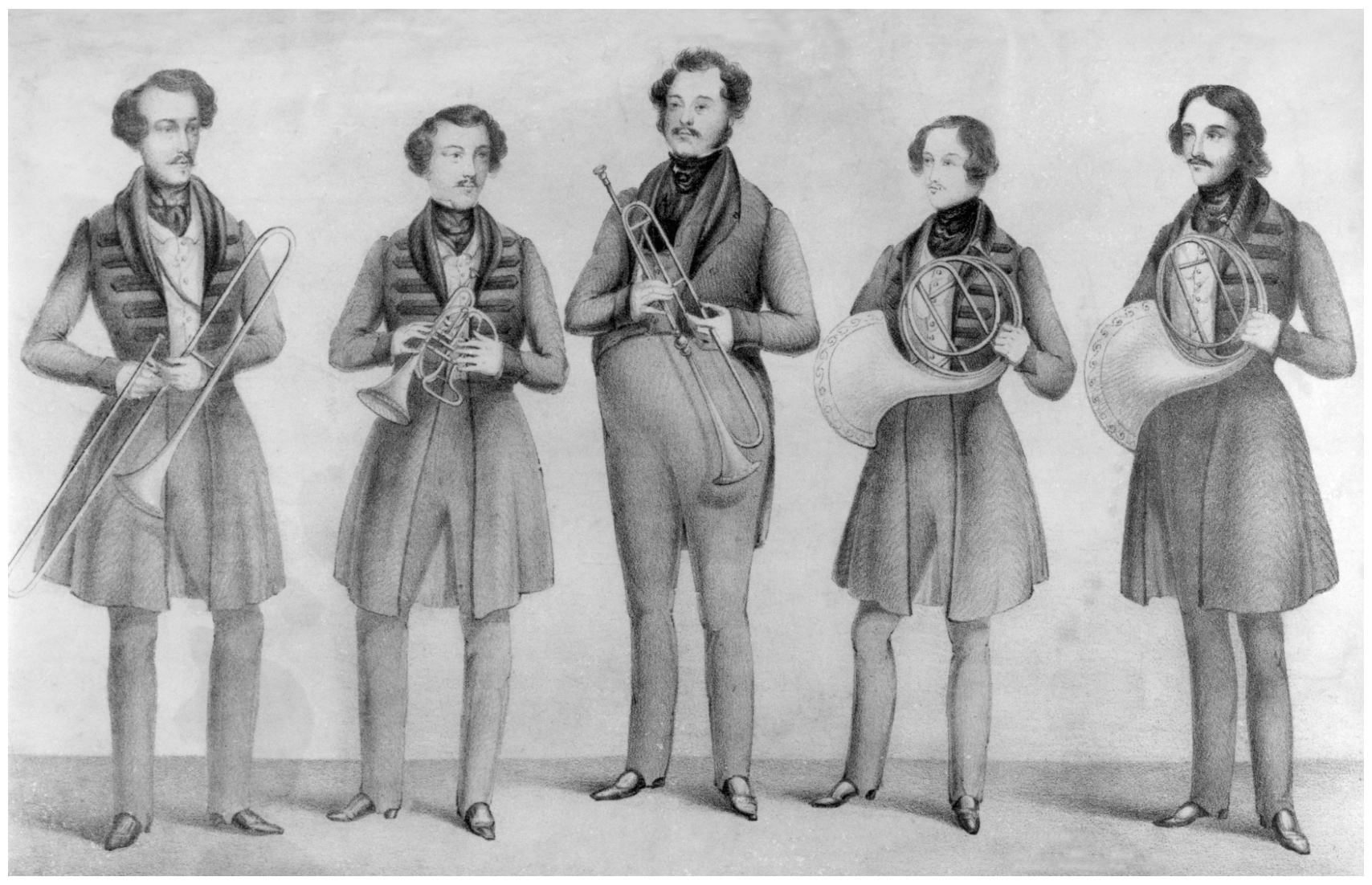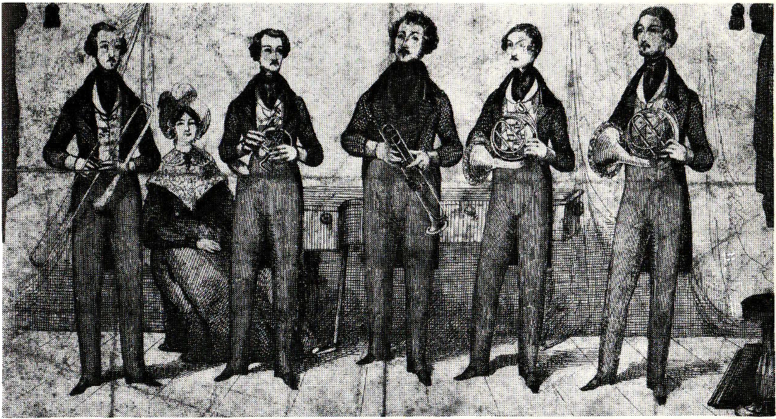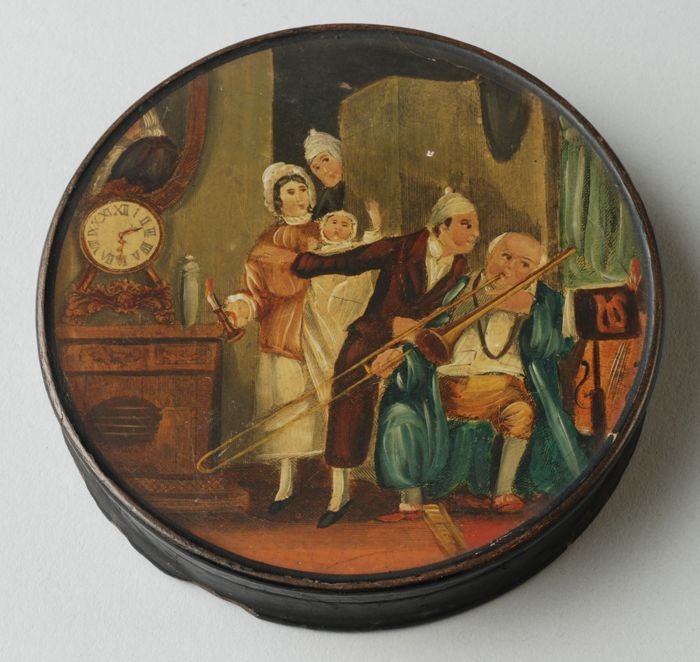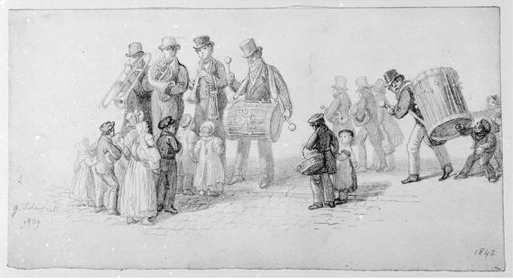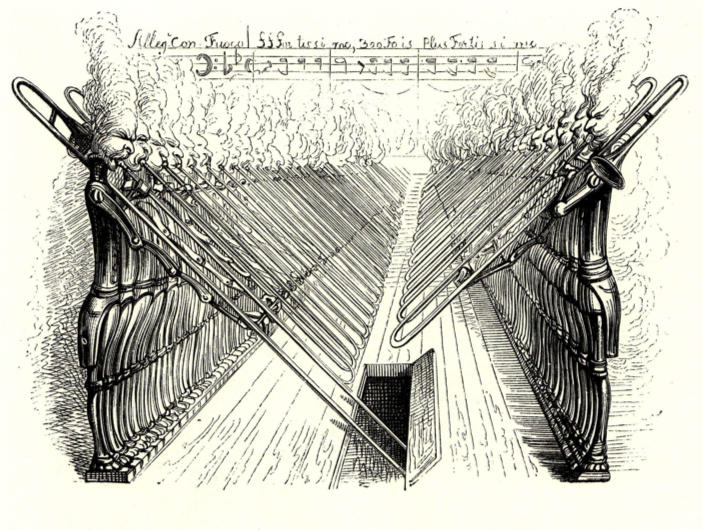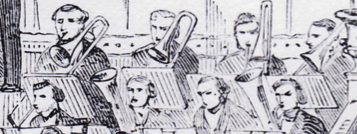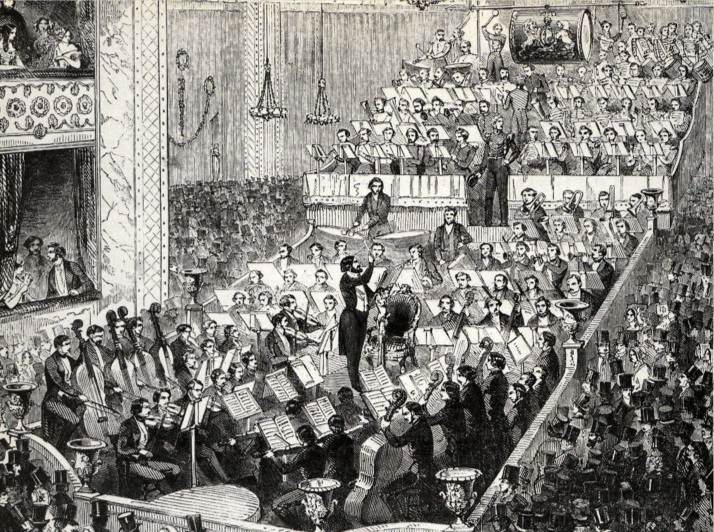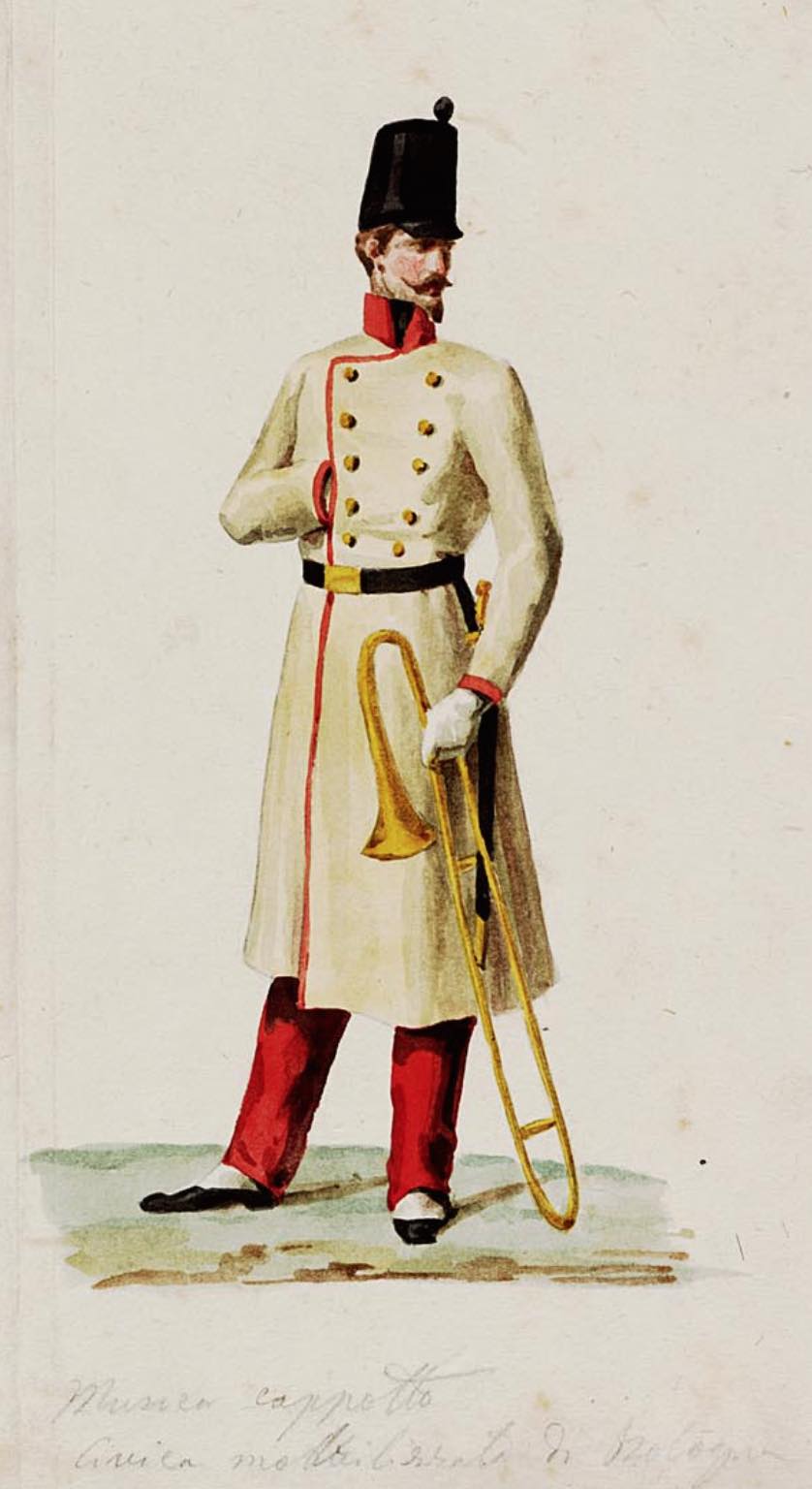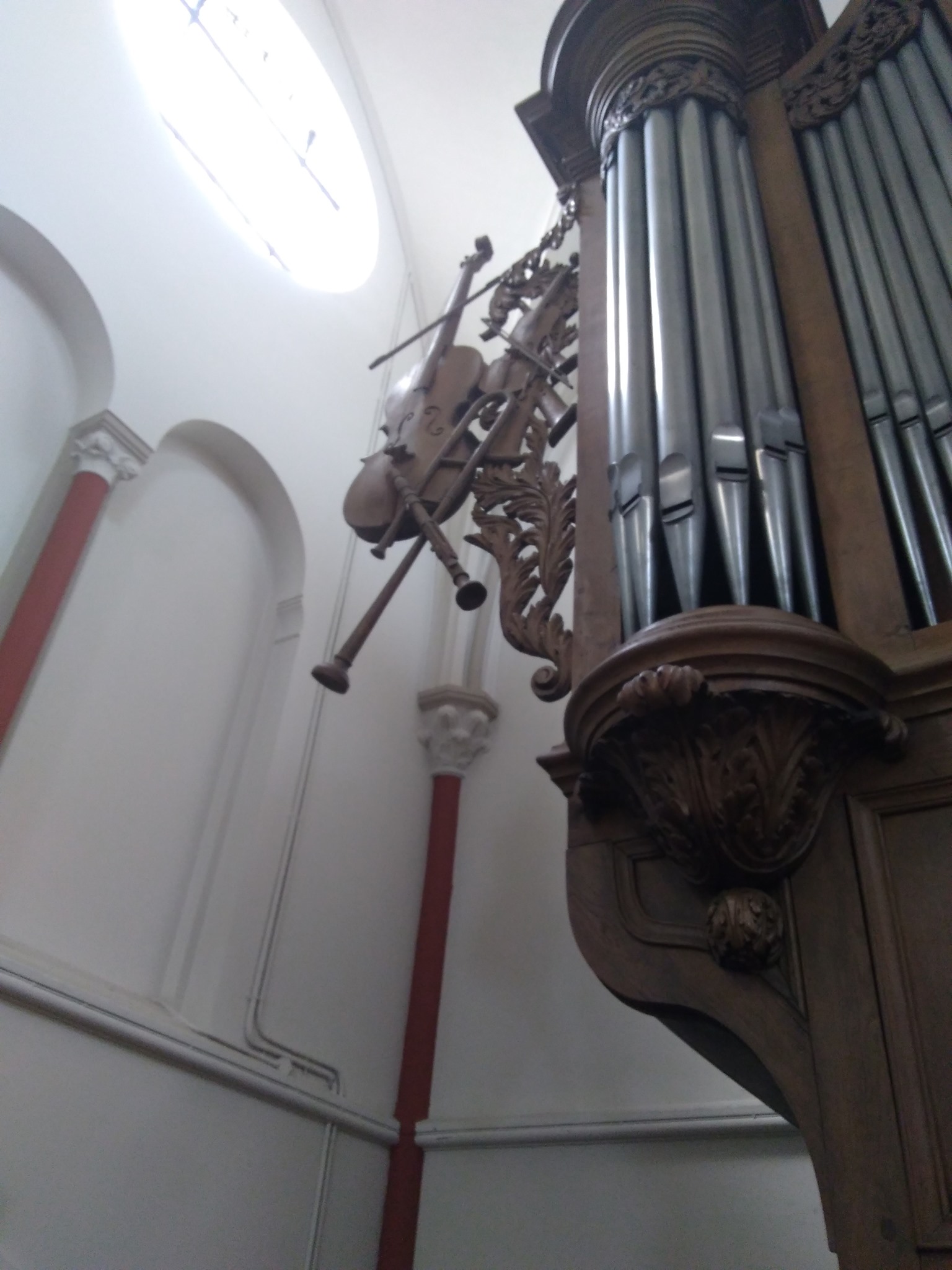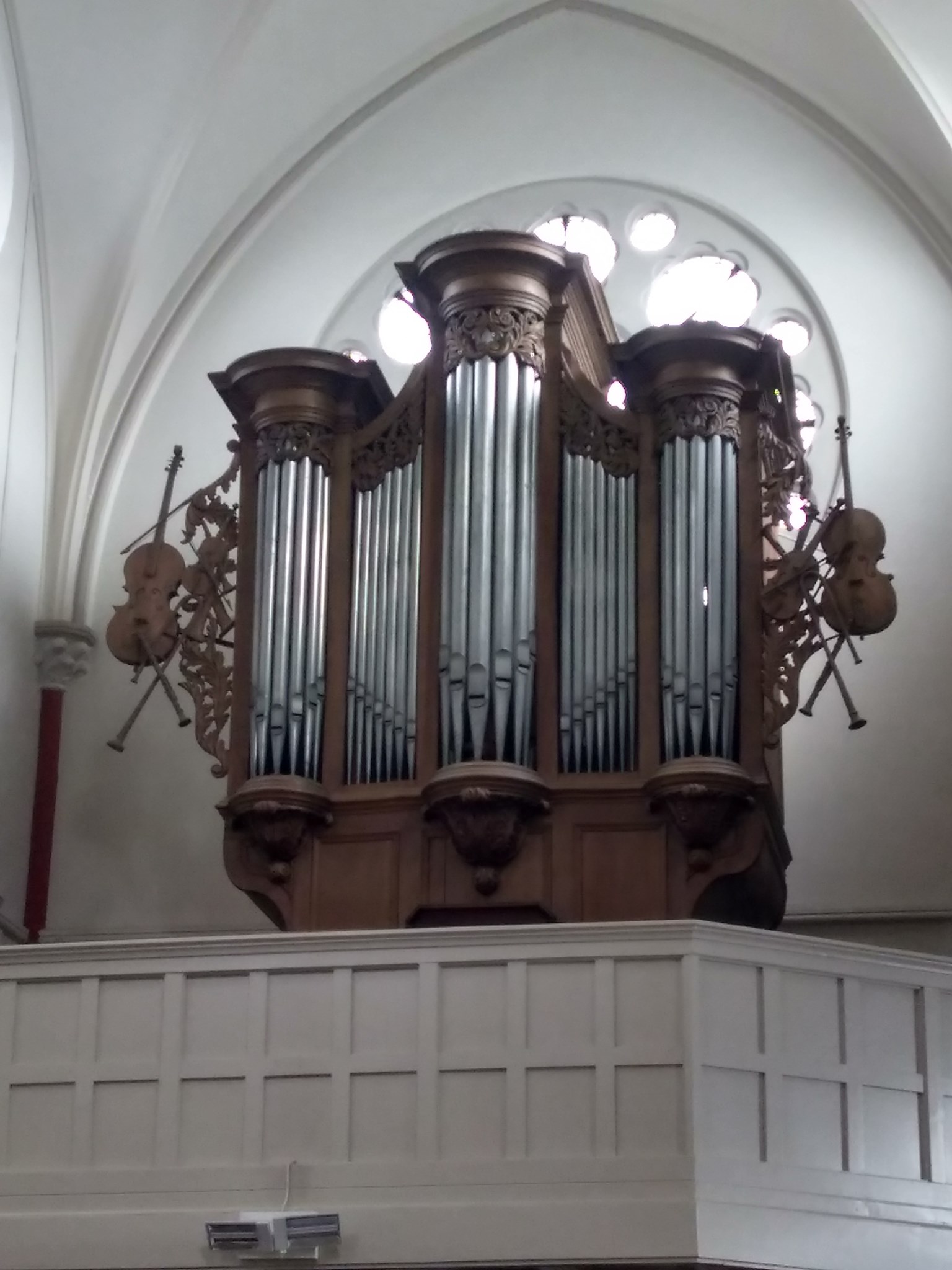1826—A drawing by George Scharf features military musicians playing various instruments, including both serpent and trombone. The writing below the drawing reads, “At the Marine Officers Mess Room, at Woolwich, during Dinner” (see below image; public domain) (British Museum).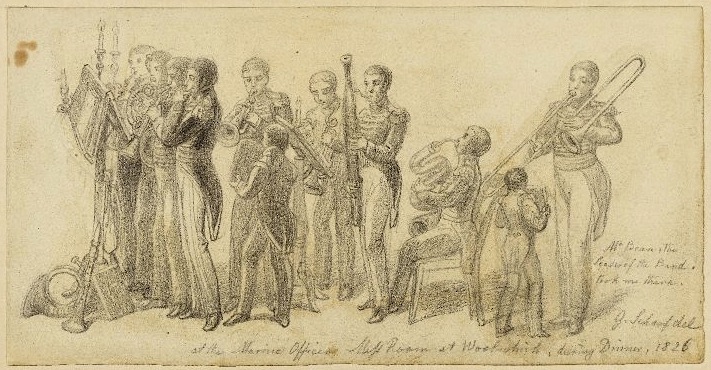
1826—London: The Royal Academy of Music concerts utilize 3 trombones (Herbert, Trombone 334).
1826—Friedrich Belcke’s Concertino isfirst performed (by the composer). Breitkopf and Härtel publishes it a few years later (between 1826 and 1829).
1826—Leipzig, Germany: Carl Queisser performs a transcription of Carl Maria von Weber’s Concerto for Horn for a benefit concert at the Gewandhaus (Lewis, Gewandhaus).
1826—Leipzig, Germany: Carl Queisser’s transcription of the Carl Maria von Weber Horn Concertino calls for multiphonics in the cadenza (Wallace, Brass Solo 250).
1826—Marriotti, Smithies, and Schoengen are trombonists in the orchestra at Weber’s funeral at Moorfields Chapel (Carse, Orchestra 491).
1826—London, England: 3 trombonists are included in the Royal Academy of Music 6th concert at the Hanover Square Rooms (Carse, Orchestra 491).
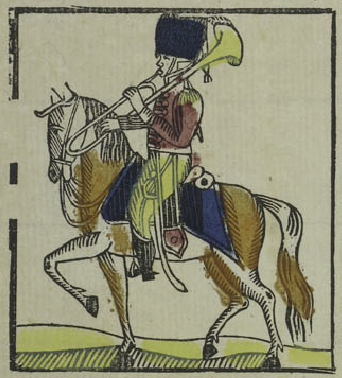 1826—Broek, Netherlands: March of the Cavalry, a “catchpenny” military print that features numerous musicians, includes a rear-facing trombone on horseback (see facing detail; public domain).
1826—Broek, Netherlands: March of the Cavalry, a “catchpenny” military print that features numerous musicians, includes a rear-facing trombone on horseback (see facing detail; public domain).
1827—Paris, France: The Opéra Comique contains 3 trombones (Herbert, Trombone 334).
1827—Vienna, Austria: Beethoven’s trombone quartet, Drei Equali, is performed at his own funeral procession (a trombone quartet alternates with a vocal version retroactively set with a Miserere text). A contemporary watercolor by Franz Stöber depicting Beethoven’s funeral shows 4 trombonists leading the enormous procession.
1827—Cherubini’s Requiem in C Minor, which calls for 3 trombones, is performed at Beethoven’s funeral (Chase 191).
1827—Carl Queisser performs the Meyer Concertino.
1827—London: A political cartoon by John Doyle entitled The Tory Band includes a trombonist in military uniform playing an instrument with an extension handle (see below image; public domain).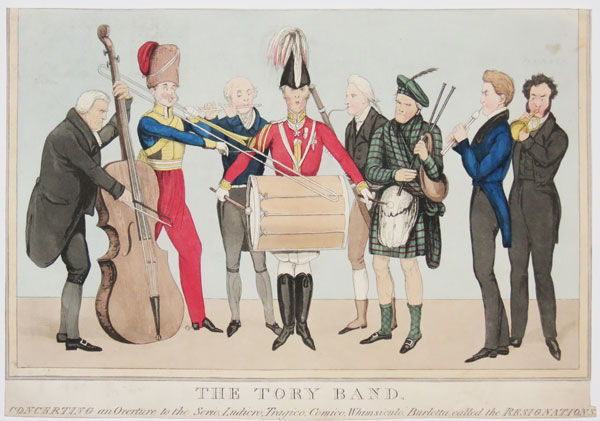
1827—Cologne, Germany: British traveler Edward Holmes witnesses a church performance: “Two horns, clarionets, bassoons, and a bass trombone, played in a smooth manner and extremely subdued, supplied the place of an itinerant organ, and supported the voices in those parts where the modulation was somewhat more learned than suits merely vocal music” (Holmes 29).
1827—Munich, Germany: British traveler Edward Holmes hears outdoor instrumental music with virtuosic trombone playing: “For the benefit of the strollers and holiday-makers in Munich, bands play twice a week in the open square of the king’s palace, which both for look and accommodation may vie with the Palais Royal in Paris. Here, while the cooling luxuries of lemonade and ice are imbibed, there is a regale of excellent instrumental music. An overture in E minor attracted my attention from the brilliancy of execution and expression with which the trombone players accomplished some most unwieldy passages for their instrument. The faces of the performers appeared as if animated by a prophetic fury, and their distended cheeks would have reminded one of the fat-faced cherubim sometimes seen on a church organ, only that they were older, redder, and accompanied by a ‘jutting friz’ of mustacio that cast a shade. Their enthusiasm, and the earnestness of their manner, were delightful, as those qualities always lead to excellence” (Holmes 61-62).
1827—Munich, Germany: British traveler Edward Holmes attends a ballet by “Cramer of Manheim,” where he is disturbed by the orchestra’s performance: “There is something certainly absurd and contemptible in employing impassioned melodies, full of meaning and tenderness, to accompany balancing and feet-twirling; and it becomes very ludicrous when, to a solemn blast of trombones and horns, such as might prepare us to wait in silent dread the sentence of an oracle, the dancer, for some mysterious and inscrutable purpose, slowly and deliberately raises her limb to an altitude as little consistent with grace as dignity” (Holmes 70-71).
1827—Munich, Germany: Edward Holmes comments on Spontini’s orchestration: “They are right in saying that the French have spoilt what was originally good in this composer [Spontini]. Every fresh opera which was intended by Spontini to make a sensation among the Parisians had more horns or trombones than the last;…as if degrees of noise constitute those of excellence in music…” (Holmes 80).
1827—Vienna, Austria: British traveler Edward Holmes attends a church service, where he is impressed with the trombones: “After the requiem was finished, a whole procession of priests and choir paraded the cathedral, at distant intervals chaunting [sic] a Gregorian phrase, accompanied by four trombones, and I have heard nothing comparable to the delicious effect these instruments produce when heard at a distance in the cathedral; their tones are so softened in the space, and they join in the gradual swell of voices upon the silence with a sweet severity. Well might the hearer who had found a seat in the choir remain listening to their echoes as they died away in those arches, and cherishing the expectation of a fresh burst” (Holmes 140-141).
1827—Dresden, Germany: British traveler Edward Holmes hears a solo trombone performance at a public park: “In this garden it is not unfrequent that concertos or solos on the bass trombone (the pausan, in Germany) are to be heard. The other evening there was a waltz with variations played, which for tone, the rapid tonguing of the notes, and extraordinary shifting, was delightful. On my complimenting the youth who had thus signalized himself, he smiled and said, ‘It requires good lungs;’ a conviction which had pressed upon me before from seeing his inflated cheeks, and the suffusion of moisture on his skin. The cavity of his chest in supplying this enormous tube must have been at every blast as the exhausted receiver of an air-pump; and the appearance of exertion would have been laughable, had not the effect counteracted any tendency of that sort. It is no more possible to affect east in an achievement of this kind, than it was for a stout man whom I once saw scrambling up a garden wall to get out of the reach of a mad dog that was pursued in full hue and cry down a country lane” (Holmes 204-5).
1827—Leipzig, Germany: British traveler Edward Holmes, after hearing a trombone solo in a public park (see above), offers praise for another trombone soloist, the well-known Carl Queisser: “Here, in one of the suburban gardens, may be occasionally heard the famed trombonist M. Queisser, by his townsmen vaunted the greatest performer of the whole empire. He is himself the proprietor of this rural retreat, having captivated the affections and wedded the form of its female possessor, thus enticing the inhabitants to discuss his viands, and enhancing his fortune, as host, by means of his music. I have heard nothing so soft, round, and deep as the tone of this extraordinary player, who has, at the age of twenty-seven, attained the most surprising mastery. At the last music meeting in Zerbst he performed a concertino on his instrument, which will not be soon forgotten. The palm of excellence for the knack in the management of wind instruments must certainly be given to Germany: in this performer there was no appearance of exertion, and the horrors of apoplexy with which swollen veins and starting eyes fill one in ordinary players, were here wholly dismissed from the mind” (Holmes 244-5).
1827—Leipzig, Germany: British traveler Edward Holmes hears music, including a trombone chorale, performed from a balcony by the local Stadtpfeifer: “From the balcony of the ancient Stadt-Haus in Leipsic the inhabitants are regaled three mornings in a week with an instrumental concert, which is played by the town musicians purely for the amusement of the citizens….The music, after a full overture or two, always concludes with a simple chorale, which, softly breathed from four trombones, produces one of the most delicate combinations I ever heard” (Holmes 255-6).
1827—Leipzig, Germany: British traveler Edward Holmes hears a performance of Spontini’s La Vestale, motivating him to complain about the composer’s orchestration for brass: “But why Julia should, with the consciousness of broken vows, and even the fear of death upon her, be called upon to overpower four horns and three trombones, is hard to guess” (Holmes 258).
1827—Franz Stöber depicts Beethoven’s funeral procession. A close detail of the very front of the procession (bottom-left) shows the 4 trombones (see detail and full image below; public domain) (source: wikimedia commons).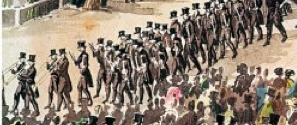
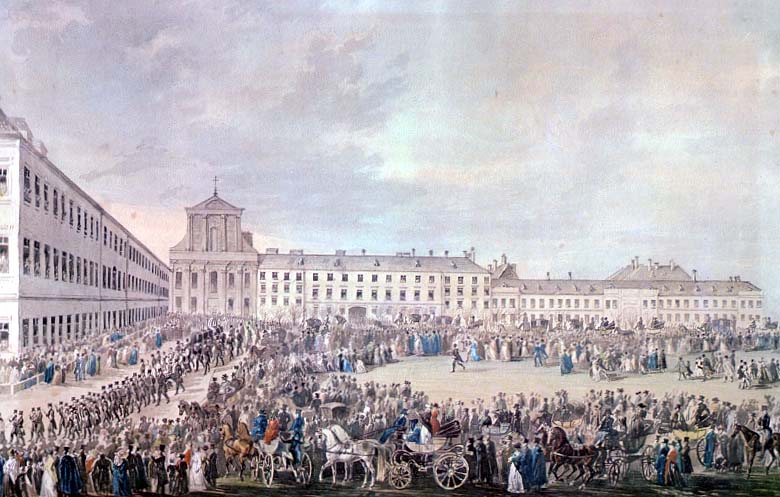
c. 1828—Paris, France: Frédéric Bouchot’s La Grisette abandonée, No. 2, second in a series of seven lithographs, includes a rear facing trombone in the music ensemble (see below image; public domain).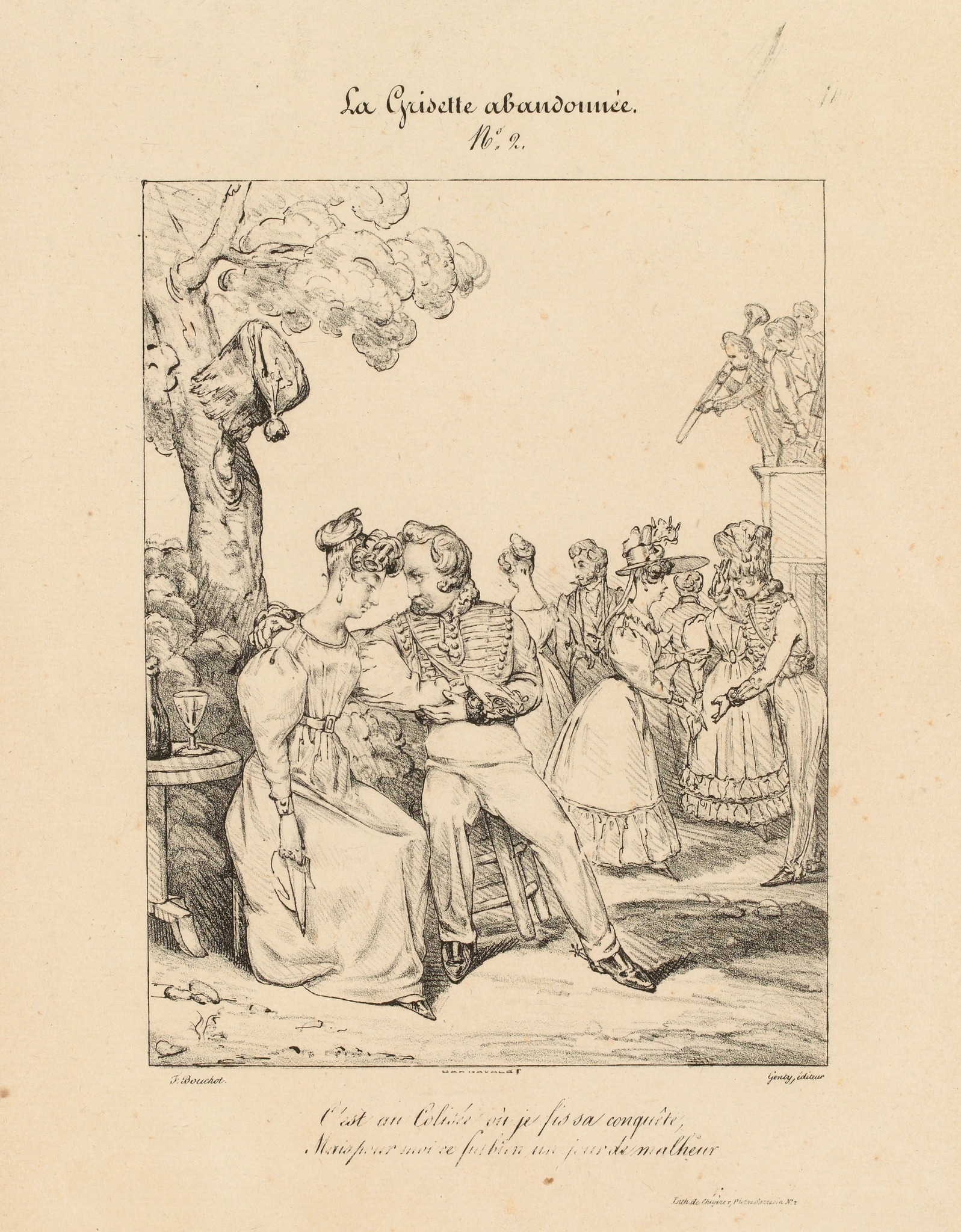
c. 1828—Wilhelm Wieprecht, charged with reforming the bands of the Prussian Cavalry Guards, includes only 3 trombones—basses—in his first band (Bate 141).
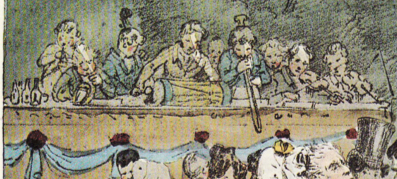
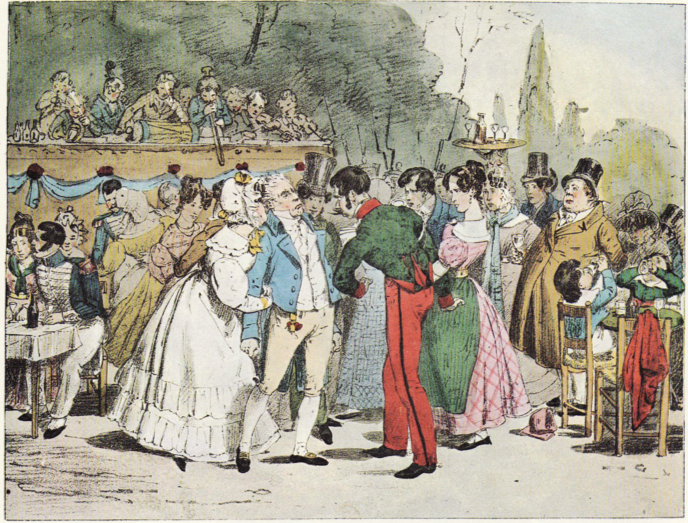 1828—Paris, France: Caricaturist J. J. Grandville depicts a country dance in his lithograph, Sundays of a Good [Middle-Class] Citizen. At the front-center of the orchestra is a rear-facing trombone (see facing detail and full image below; public domain) (Fromrich 29).
1828—Paris, France: Caricaturist J. J. Grandville depicts a country dance in his lithograph, Sundays of a Good [Middle-Class] Citizen. At the front-center of the orchestra is a rear-facing trombone (see facing detail and full image below; public domain) (Fromrich 29).
1828—Typical instrumentation for German military bands, according to J. A. Kappey, includes “3 slide bass trombones” in a band of 21 members (Dudgeon, Keyed Bugle 41).
1828—Paris, France: There are 3 trombonists in the Société des Concerts (Conservatoire Concerts) (Carse, Orchestra 493).
1828—Nemetz writes a method for trombone (Dudgeon 195).
1828—London, England: The Earl of Mount Edgcumbe complains about opera in his Musical Reminiscenses: “It is really distressing to hear the leading voice strained almost to cracking in order to be audible over a full chorus and full orchestra, strengthened often by trumpets, trombones, kettle-drums, and all the noisiest instruments” (Edgcumbe 124).
1828—Nuremberg, Germany: Ludwig Emil Grimm’s Morning Service at Albrecht Dürer’s Grave, depicting a commemoration of the 200th anniversary of Dürer’s death, features a quartet of trombones performing at the service (see detail and full image below; public domain) (special thanks to Iris Tjoonk).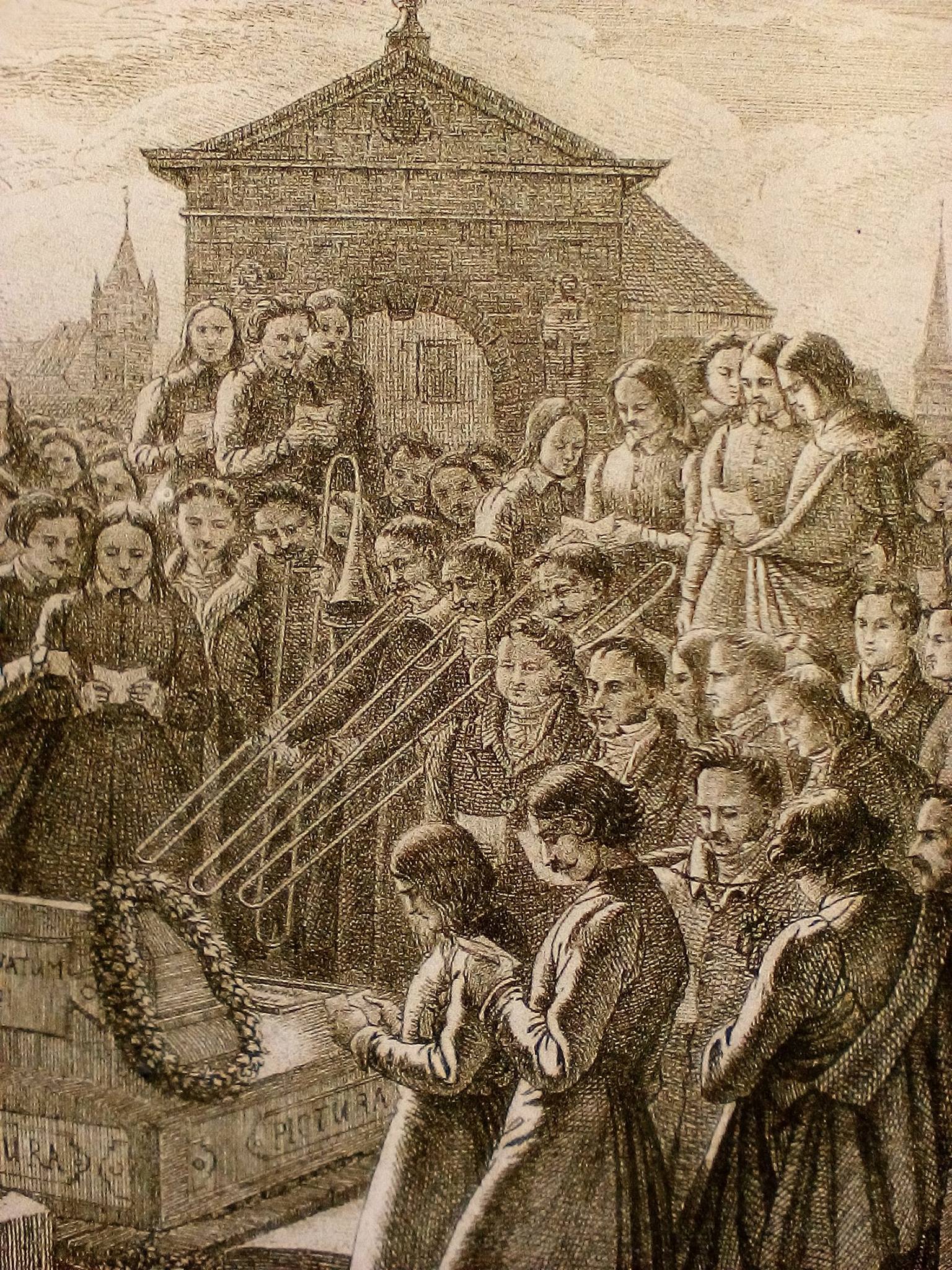
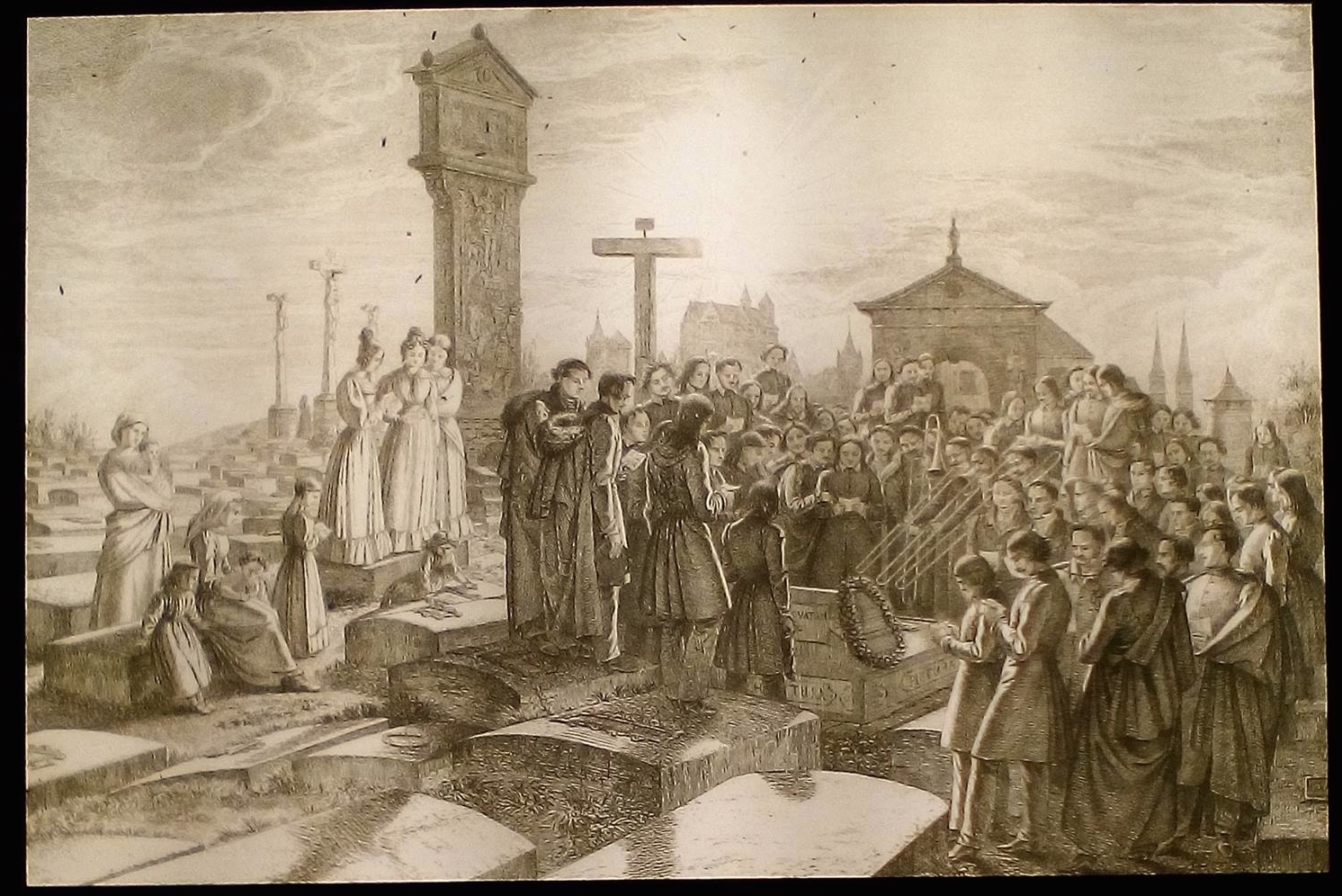
1828—Leipzig, Germany: Carl Queisser performs a new work by C.G. Müller, the Concertino für Bassposaune, at the Gewandhaus (Lewis, Gewandhaus).
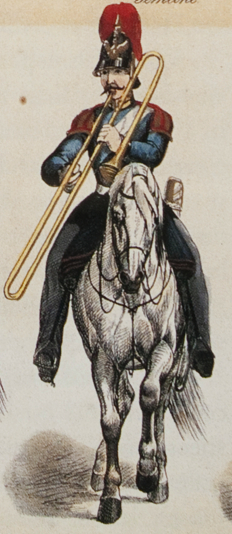 c. 1829—Mainz, Germany: Artist Joseph Scholz depicts a group of 4 military musicians of the Prussian Army on horseback in an image titled Preussisches Heer–Garde Artillerie (see facing detail of trombonist; public domain) (Ryan, Paper Soldiers).
c. 1829—Mainz, Germany: Artist Joseph Scholz depicts a group of 4 military musicians of the Prussian Army on horseback in an image titled Preussisches Heer–Garde Artillerie (see facing detail of trombonist; public domain) (Ryan, Paper Soldiers).
c. 1829—Sweden: Two wind players from the Swedish Royal Court Orchestra, Carl Anton Philipp Braun and Bernard Henrik Crusell, collaborate on Adagio and Polonaise for solo Kenthorn and 2 keyed bugles, 4 horns, 2 trumpets, and alto, tenor and bass trombone. Swedish cavalry and artillery regiments throughout the country likely adapt this instrumentation. The same instrumentation is also used in Braun’s arrangement of the Adagio movement of Beethoven’s Septet, Op. 20 (Dudgeon, Keyed Bugle 166).
1829—Gioachino Rossini, William Tell.
1829—Mannheim, Germany: British traveler Vincent Novello attends a performance of Aubert’s opera La Muette de Portici, complaining about the overbearing nature of the orchestra: “Finale to 1st Act too violent and noisy—the crowing, shouting, bawling, and the furious crashing of the Orchestra was enough to split our ears—it was absolutely frightful….The finale [2nd act] again consisting of more trumpeting, drumming, bursting of trombones and smashing of cymbals, and upon the whole the melodies want delicacy, sweetness and expression. Orchestra too violent and noisy throughout and, though accurate as to time, but coarse in execution” (Novello 265-7).
1829—Leipzig, Germany: Carl Queisser performs the Müller Concertino on two separate occasions the Gewandhaus. The review of the first performance in the Allgemeine musikalischeZeitung says simply, “Mr. Q. performed masterfully” (Lewis, Gewandhaus).
1829—Salzburg, Austria: British traveler Vincent Novello attends a Mass at the Salzburg Cathedral. Although he does not specify the complete makeup of the orchestra, he comments specifically on the trombones: “The best Performers were the three Trombone players, who produced a fine tone and added much grandeur to the general effect” (Novello 104).
1829—Vienna, Austria: British traveler Vincent Novello attends a performance of Mozart’s Don Giovanni at the Kärntnerthor Theatre. His evaluation of the orchestra’s winds is cursory, although the trombones draw brief praise: “The Oboe I did not like—but the Trombones were good—as were also the Bassoons and Clarionets…” (Novello 177).
1829—Munich, Germany: British traveler Vincent Novello hears the Royal Military Band, which includes trombones: “In the Evening at 6 we went to the Garden belonging to the King’s Palace (the Hof Garten) to hear the Military Band. It consisted of two Portions, the Brass Band and the Regular Military Band—which consists of about half a dozen 8ve Clarionets, the same number of common Clarionets, 2 Flutes, an octave Flute, 2 Bassoons, 4 Horns, 4 Trumpets, 2 Trombones, 2 Bass Horns, Long Drum, Side Drum and Cymbals” (Novello 274).
1829—Antwerp, Belgium: British traveler Vincent Novello attends Mass at the Antwerp Cathedral, where he hears Eybler’s Third Mass, de Sancto Leopoldo, in D. His notes include the following brief remark: “at the Et Resurrexit, trombone good” (Novello 287-8).
1829—Antwerp, Belgium: British traveler Vincent Novello hears Haydn’s Sinfonia in B-flat during the procession at the church of St. Jacques. Although the piece does not originally call for trombone, at least one is apparently used, as Novello is disappointed by the performance: “…it is in a very elevated style of writing and full of energy. Effect spoiled by the Trombone nearly ½ a tone too flat throughout” (Novello 289-90).
1829—Salzburg, Austria: British traveler Vincent Novello attends Mass at the Salzburg Cathedral. The trombones, which include a full complement of alto, tenor, and bass, receive special praise and are the only wind instruments in the orchestra: “The Orchestra was placed in the right-hand Gallery near the Altar against one of the large Pillars which support the Dome. It consisted of two first Violins, a second Violin, Tenor [viola] and Double Bass (no Violoncello), three trombones (alto, tenor and bass), and the Organ….The best performers were the three trombone players, who produced a fine tone and added much grandeur to the general effect” (Novello 303-4).
1829—Vienna, Austria: British traveler Vincent Novello attends Mass at St. Stephen’s Cathedral, where trombones are again the only wind instruments in the orchestra: “At 9 o’clock High Mass. The band consisted of about half a dozen Violins, Viola, Violoncello and Double Bass, and Trombones” (Novello 310).
c. 1830—Vienna, Austria: Uhlmann, a Viennese brass manufacturer, improves on Riedl’s valve design, making B-flat and G trombones with the double Vienna valve (Carse, Musical 258).
c. 1830—Vienna, Austria: K.k. Österreichischer Militair Leichen-Conduct, lithograph no. 8 from a series edited by Michael Tretsentsky, shows a military band that includes trombones with both traditional and rear-facing bells (see below image—click to expand; public domain) (Pirker).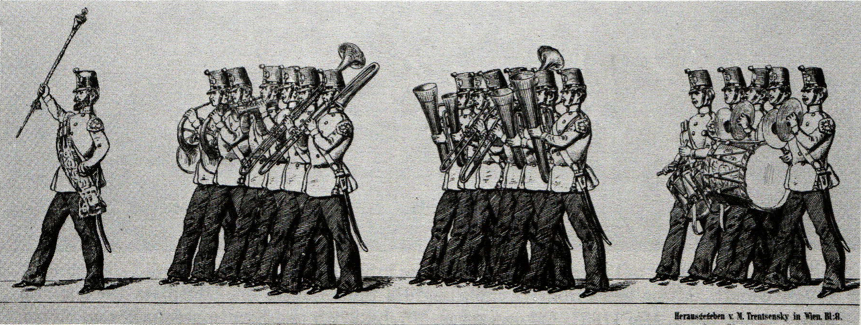
c. 1830s—Strasbourg, France: A rear-facing trombone is made by manufacturer Charles Kretzschmann (Heyde, Metropolitan).
1830—Strasbourg, France: Sometime before this date, a print by Jacques Perlasca of a mounted chasseur band illustrates both a standard rear-facing trombone and a rear-facing buccin (see detail and full image below; public domain) (Ryan 23).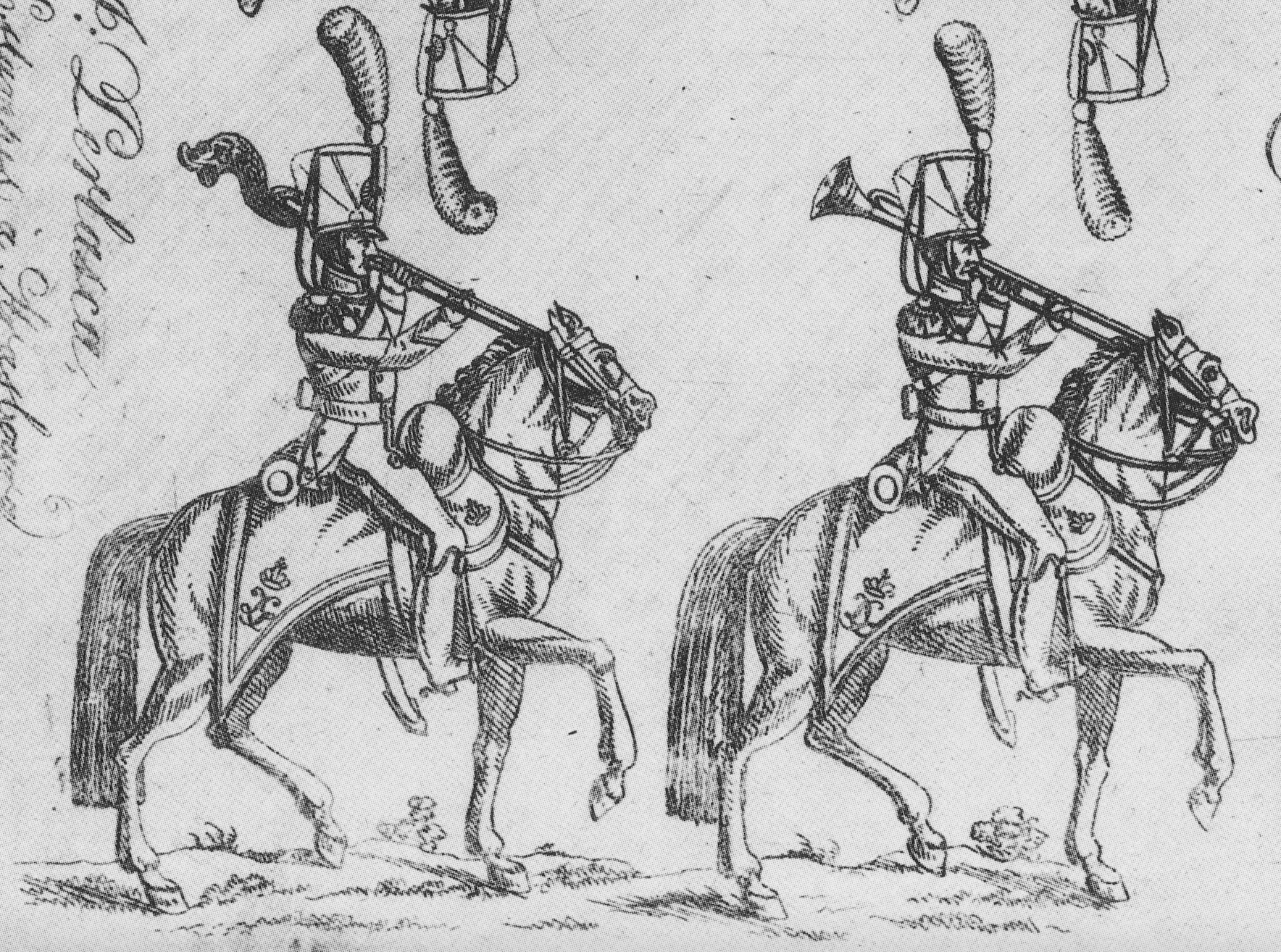
1830—Leipzig, Germany: The Gewandhausorchester contains 3 trombones (Herbert, Trombone 334).
1830—Paris, France: The Royal Music orchestra contains 1 trombone (Herbert, Trombone 334).
1830—Germany: The Dortmund Concert Orchestra contains 3 trombones (Herbert, Trombone 334).
1830—Leipzig, Germany: Correspondent for Allgemeine musikalischeZeitung says, “Truly we live in an age of trombones” (Lewis, Gewandhaus).
 1830—Hector Berlioz writes Symphony Fantastique, one of the earliest orchestral works to give trombones a prominent, independent role. Regarding the orchestration of the top trombone part, Berlioz says, in an early document listing the instrumentation, “The alto trombone part must not be played on a big trombone, as is often done in France: I demand a true alto trombone” (see above image) (Macdonald 210; Massip 33).
1830—Hector Berlioz writes Symphony Fantastique, one of the earliest orchestral works to give trombones a prominent, independent role. Regarding the orchestration of the top trombone part, Berlioz says, in an early document listing the instrumentation, “The alto trombone part must not be played on a big trombone, as is often done in France: I demand a true alto trombone” (see above image) (Macdonald 210; Massip 33).
1830—London, England: Auguste Bertini, a musician active in France, Italy, and England, publishes New System for… All Musical Instruments, an instruction book for a variety of instruments. He mentions alto, tenor, and bass trombones, the alto apparently pitched in E-flat (Myers, Fingering Charts).
c. 1831—Victor Cornette publishes his Methode de trombone (see illustration below; public domain).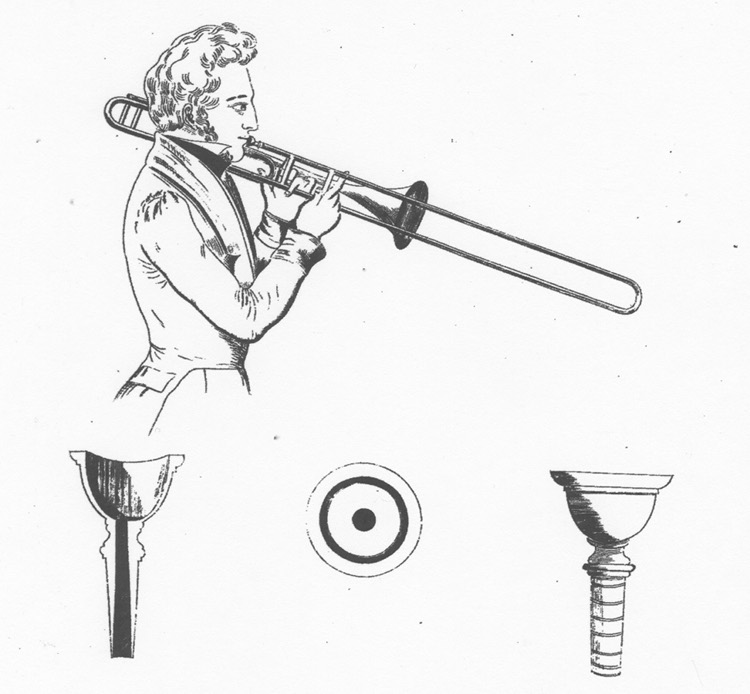
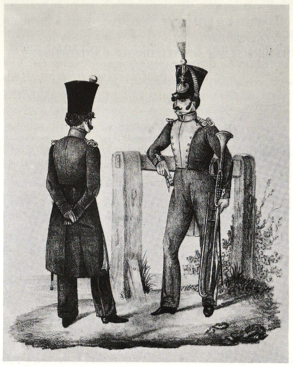 1831—Belgium: A lithograph titled Musiciens d’infanterie belge, or “Belgian infantry musicians,” portrays a musician holding what appears to be a rear-facing trombone (see facing image; public domain) (Bibliotheque royale Albert I; Wangermée vol. 2, 264). Another image (below facing; public domain), apparently another version of the same image, depicts a Dutch military musician holding a rear-facing trombone (source: New York Public Library Digital Gallery).
1831—Belgium: A lithograph titled Musiciens d’infanterie belge, or “Belgian infantry musicians,” portrays a musician holding what appears to be a rear-facing trombone (see facing image; public domain) (Bibliotheque royale Albert I; Wangermée vol. 2, 264). Another image (below facing; public domain), apparently another version of the same image, depicts a Dutch military musician holding a rear-facing trombone (source: New York Public Library Digital Gallery).
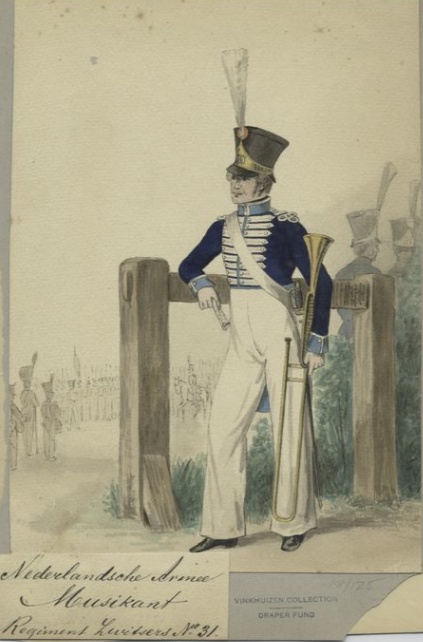 1831—Leipzig, Germany: Carl Queisser performs as soloist on two different occasions at the Gewandhaus. The latter performance is the premier of a work by Friederich August Kummer, Concertino für Bassposaune. The review in Allgemeine musikalischeZeitung says, “Our oft praised Mr. Q. performed wonderfully on a new and very difficult concertino by Mr. Kummer” (Lewis, Gewandhaus).
1831—Leipzig, Germany: Carl Queisser performs as soloist on two different occasions at the Gewandhaus. The latter performance is the premier of a work by Friederich August Kummer, Concertino für Bassposaune. The review in Allgemeine musikalischeZeitung says, “Our oft praised Mr. Q. performed wonderfully on a new and very difficult concertino by Mr. Kummer” (Lewis, Gewandhaus).
1831—Rome, Italy: Hector Berlioz, writing from Rome, voices his disgust with the military music there: “…but for this fatal imagination of mine, I should not have been so disgusted by the impious, coarse cacophony of those two groups of quacking clarinets, roaring trombones, crashing drums, and circus trumpets. Had it ushered in old Silenus, riding on his ass, and escorted by a troupe of coarse satyrs and bacchantes, it would have been highly appropriate…” (Whitwell, 19th Century 102).
1831—Erfurt, Germany: J.I. Müller, Prelude, Chorale, Variations and Fugue. Müller (1774-1839) is a cantor in Erfurt (Germany) and presumably composes the solo for Carl Queisser for a festival held there. It becomes one of the more popular Romantic-era trombone solos.
1831—Paris, France: The earliest example of trombone pedal notes notated in music, Ferdinand Hérold’s opera, Zampa, is composed (Gregory 60). The pedals are found in the first act finale, where 3 tenor trombones hold pedal B-flat in unison for ten bars (Macdonald 218).
1831—St. Petersburg, Russia: Trombonists Schmidt and son perform in concert but are unable to meet expenses. They had spent a significant period of time in Riga, concertizing on 5 separate dates in the theater, as well as participating in a performance of Mozart’s Don Giovanni. Records also show that later, in 1840, a trombonist of the same name (Schmidt) from the Dresden Court Chapel gives a performance in Riga (Tarr, East Meets West 44).
1832—Leipzig, Germany: Carl Queisser performs as soloist on two separate occasions at the Gewandhaus, performing the Müller Concertino and a transcription of the Carl Maria von Weber Concerto for Horn. The reviewer of the Weber performance says, in the Allgemeine musikalischeZeitung, “The work does not seem to us to be entirely suited for the [trombone]” (Lewis, Gewandhaus).
1832—New Orleans, Louisiana: A trombone soloist is featured on a set of variations at the popular Camp Street Theater (Kmen 210).
1832—London, England: The King’s Theatre contains 3 trombones (Carse, Orchestra 488).
1832—Hamburg, Germany: The Hamburg Opera contains 3 trombones (Herbert, Trombone 334).
1832—Birmingham, England: The English Birmingham Festival is noted for its “introduction of nine trombones in addition to the organ at the church service” (Mansfield).
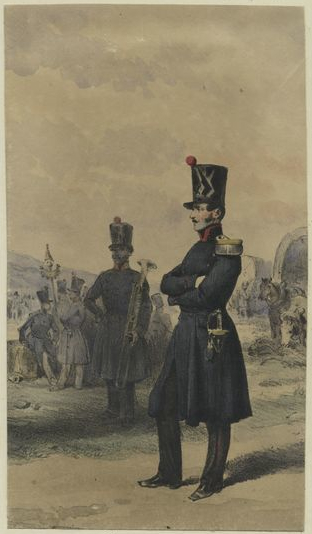 1832—Belgium: A print by Belgian artist Jean-Baptiste Madou titled Officier Garde Civique Premier depicts an officer of the Belgian Civil Guard. Behind the officer stands a military musician who appears to be holding a rear-facing trombone (see facing image; public domain) (source: New York Public Library Digital Gallery). For a similar image, see 1831 (above).
1832—Belgium: A print by Belgian artist Jean-Baptiste Madou titled Officier Garde Civique Premier depicts an officer of the Belgian Civil Guard. Behind the officer stands a military musician who appears to be holding a rear-facing trombone (see facing image; public domain) (source: New York Public Library Digital Gallery). For a similar image, see 1831 (above).
1833—Leipzig, Germany: Carl Queisser performs the Meyer Concertino at the Gewandhaus.
1833—London, England: The Philharmonic Society contains 3 trombones (Herbert, Trombone 334).
1833—Vienna, Austria: Franz Lachner writes Andante in E-flat for 2 valve trumpets, 4 valve horns, and 3 trombones—the brass section of the Künstlerverein, a forerunner of the Vienna Philharmonic.
1833—Canada: In Upper Canada, the Children of Peace, a separatist sect from the Quakers, supports a band that includes trombone (Mendoza de Arce 182).
1833—An engraving by Charles James Grant features a very unusual looking trombone. The full caption for the engraving reads, “The Royal ‘Feast of Harmony’ in Vestminster Habby: Alias ‘The Music Shop Over the Vay,’ in which John Bull Figured in the Capacity of Double Drum and Old Gery as Calfskin Thumper!!!” According to the British Museum, the images depicts the king conducting an orchestra of politicians and John Bull (meaning a typical Englishman. See below image; public domain.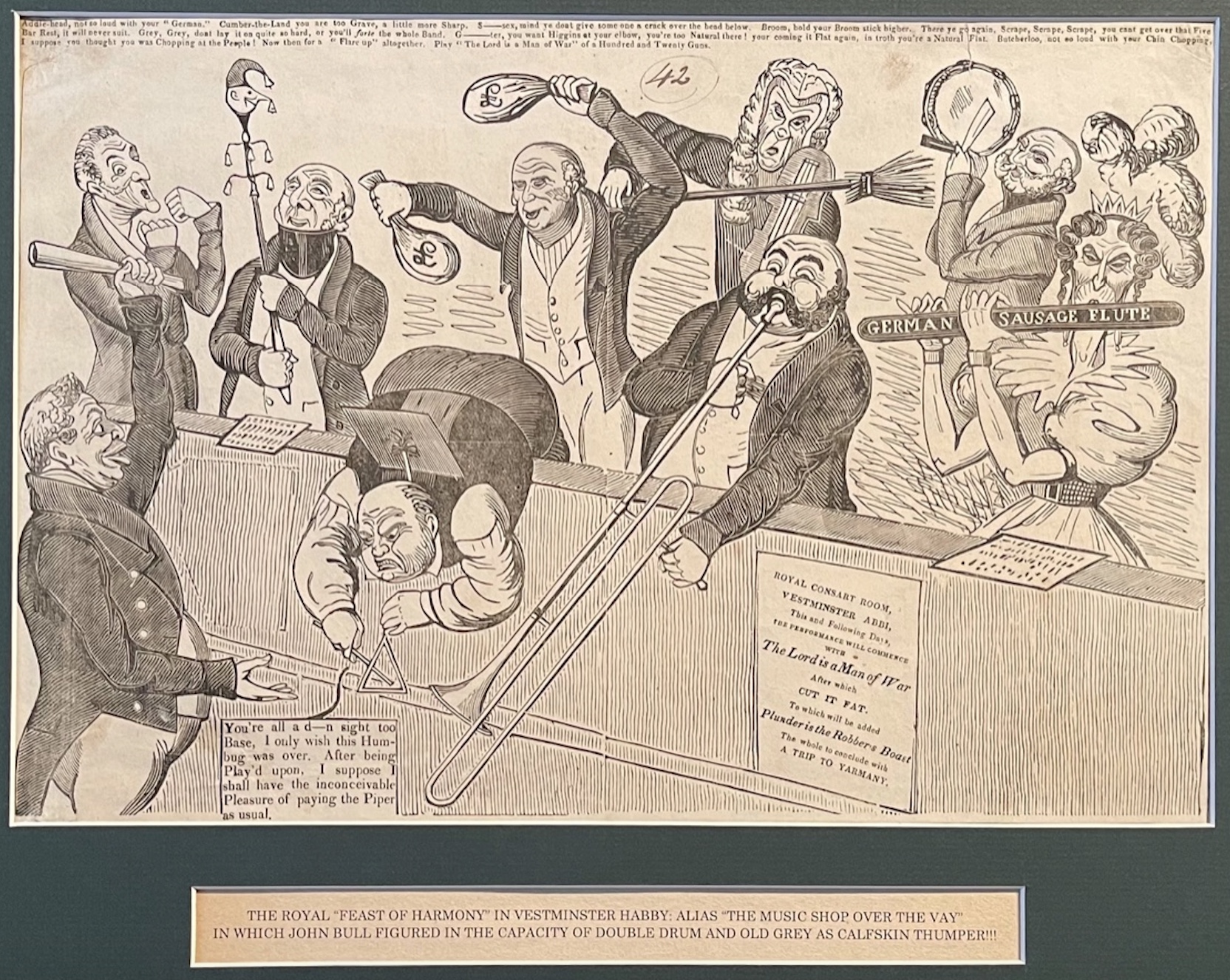
1833-36—Paris, France: Felix Vobaron runs the trombone studio at the Paris Conservatory (Dudgeon 195).
1833-1900—Turnhout, Belgium: A catchpenny print entitled Harmonie, probably published by Glenisson and Van Genechten, features musicians playing various instruments, including a buccin (trombone with dragon-head bell) and a standard trombone (see below detail; public domain) (Catchpenny Prints of the Dutch Royal Library).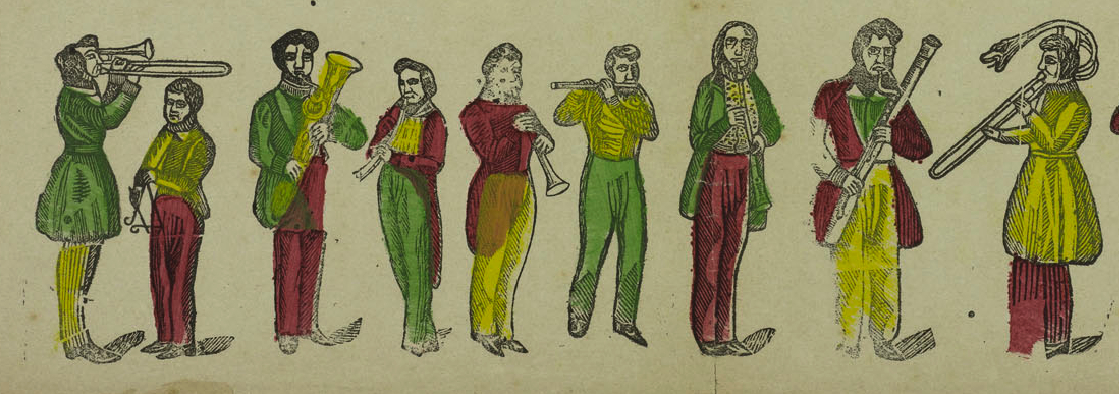
1834—New Orleans, Louisiana: The trombonist of the Orleans orchestra is featured soloist at the Camp Street Theater (Kmen 210).
1834—New York: According to the American Musical Journal, “On the closing of the Opera House, some of the spirited members of the Orchestra entered into an arrangement with Mr. Niblo for the use of his Saloon and Garden, and during the season a series of most excellent concerts have been given at this delightful place of resort…The violin solos of Mr. Halma, double base [sic] of Casolani, flute of Messrs. Cuddy and Kyle, trumpet of Gambati and Norton, horn of Aupick, trombone of Cioffi, and harp of Trust, formed a prominent feature in these concerts” (Guion, Four American).
1834—New York: At Niblo’s Pleasure Garden, William Niblo stages a competition between valve trumpeter Alessandro Gambati and the slide trumpeter John Norton. Scuffles break out in the crowd of three to four thousand, so trombonist Felippe Cioffi comes to the front, marches through the center of the gathering playing “Hail Columbia,” and most of the crow follows him out (Wills, Orchestra 163).
c. 1834—England: Three very similar prints depicting the Distin Family Brass Quintet, an ensemble known for adopting Adolph Sax’s valve instruments, include a member holding a slide trombone, indicating the instrument was probably used at least during the early days of the ensemble (see below 3 images; public domain) (top image, by John William Gear: New York Public Library; bottom image: Baines, Brass plate XI). According to Dudgeon, “The early quintet performances of the Distin family used various combinations of keyed bugle, cornopean, slide trumpet, natural horns, and trombone; all made by the firm of Pace. By 1844, the Distins met Adolph Sax and made the switch to valved saxhorns” (Dudgeon, Keyed Bugle 28).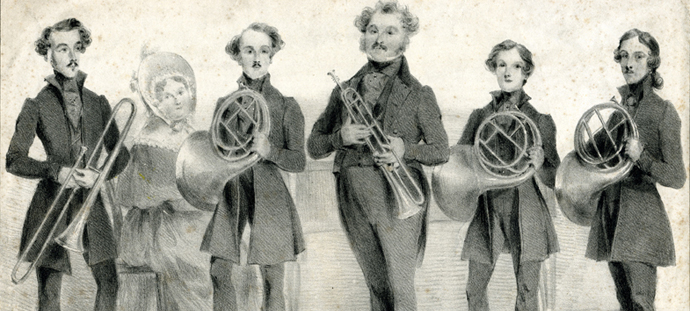
1834—Leipzig, Germany: Carl Queisser solos twice at the Gewandhaus. Plays an unspecified work the first time, Müller Concertino the second performance.
1834—Leipzig, Germany: A review in Allgemeine musikalischeZeitung of a solo performance by a trombonist named Fritsche with the Euterpe Orchestra says he performed with such “bravura and tone that he earned as much applause as Mr. Queisser” (Lewis, Gewandhaus).
1834—Hector Berlioz, complaining about Mozart’s depiction of the Last Judgment in the Requiem, says, “Why just one trombone to sound the terrible blast that should echo round the world and raise the dead from the grave? Why keep the other two trombones silent when not three, not thirty, not three hundred would be enough?” (Macdonald 220).
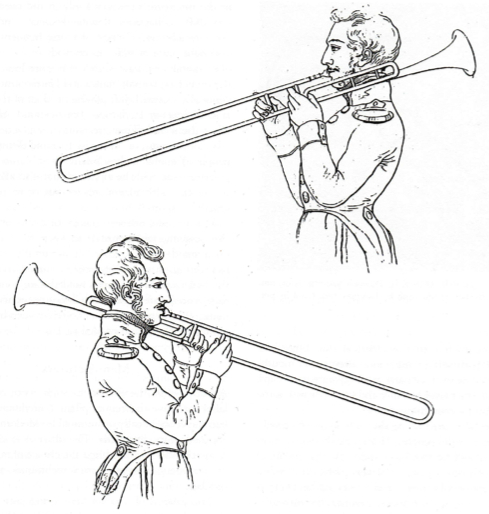 1834–Paris, France: In his Grande Méthode de trombone Vobaron includes a graphic showing a rear-facing trombone from both sides (see facing image; public domain).
1834–Paris, France: In his Grande Méthode de trombone Vobaron includes a graphic showing a rear-facing trombone from both sides (see facing image; public domain).
c. 1835—Paris, France: An E-flat alto trombone is manufactured by Charles-Joseph Sax (Haine 125).
c. 1835—England: An illustration of a theatre orchestra as part of a toy theatre shows a trombone with a slide extension handle (see below image; public domain).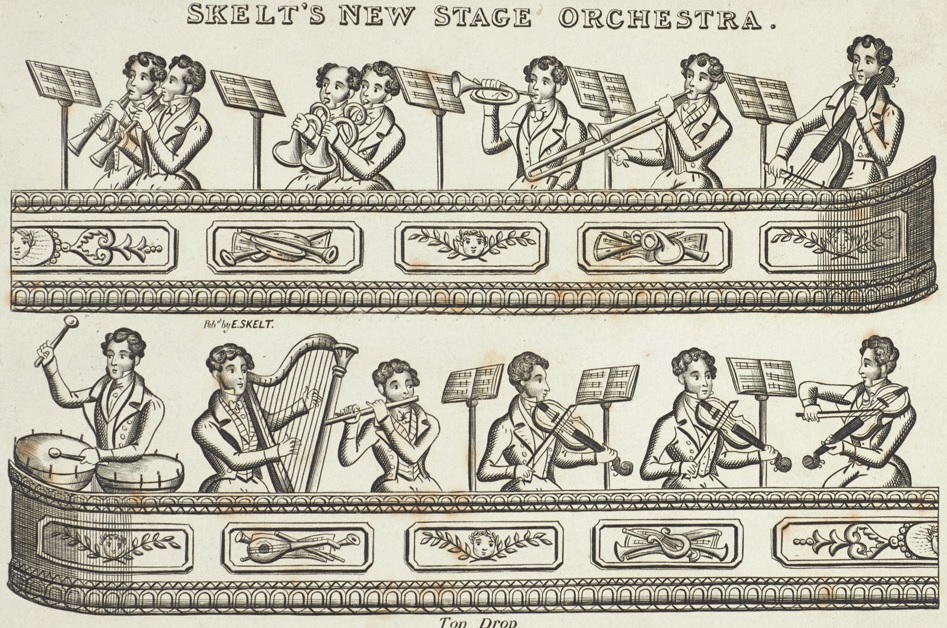
1835—New York: The American Musical Journal offers the following report of a concerto performance by trombonist Felippe Cioffi: “Signor Cioffi played a concerto, in a most inimitable style; the beauty of this performer’s tone, fine execution and every other requisite that constitutes good performance, renders every instance of their exhibition a source of the greatest pleasure” (Guion, Four American).
1835—Hector Berlioz composes Le cinq mai, in which he begins writing for 3 trombones in tenor and bass clefs rather than alto, tenor, and bass. It is presumed that it is at this point that he intends all 3 parts to be played on tenor trombone, as specified in the Requiem, rather than performed on alto, tenor, and bass (Macdonald 209).
1835—Leipzig, Germany: Carl Queisser performs the Müller Concertino at the Gewandhaus, with Felix Mendelssohn conducting. The review in Allgemeine musikalischeZeitung says that Queisser, an artist of the greatest brilliance, “could not escape the stormy applause of the audience” (Lewis, Gewandhaus).
1835—New York/New Orleans: Trombonist Felippe Cioffi leaves New York along with several other leading instrumentalists to join the St. Charles Theater orchestra in New Orleans—at the time, the largest concert hall in the United States. Cioffi soon becomes a “frequent attraction” as soloist, and is featured at every major venue in the area, including the St. Charles Theater, St. Charles Hotel, St. Louis Hotel, Vauxhall Gardens, Carrollton Gardens, and St. Louis Cathedral (Kmen 138, 210; Guion, Four American).
1835—New Orleans, Louisiana: Felippe Cioffi performs as featured soloist at the St. Charles Theater. Both the audience and the other musicians of the orchestra demand an encore, a sight which the popular newspaper The Bee proclaims unprecedented. The editor of the The Bee remarks, “Though we are not oversolicitous to hear such an instrument performed alone, we were very much pleased with the skill and taste evinced by Cioffi” (Kmen 210).
1835—New Orleans, Louisiana: At the St. Charles Theater, when a popular French ballerina dances a new ballet, “The Revolt of the Harem,” she is accompanied by Felippe Cioffi “in a grand trombone solo by Weber” (Kmen 140, 211). A newspaper advertisement for a “grand ballet dance” at the St. Charles Theatre mentions a trombone solo by Felippe Cioffi: “In this beautiful dance Signior Cioffi will accompany Madamoiselle Celeste in a grand Trombone Solo. The whole of the music by Carl Maria von Weber” (New Orleans Commercial Bulletin).
1835—Nuremberg, Germany: An alphabet picture book by George Nicolaus Renner features an image of “Musikdirector” that includes a rear-facing trombone (see upper-right below detail; public domain) (Nuremberg, German National Museum).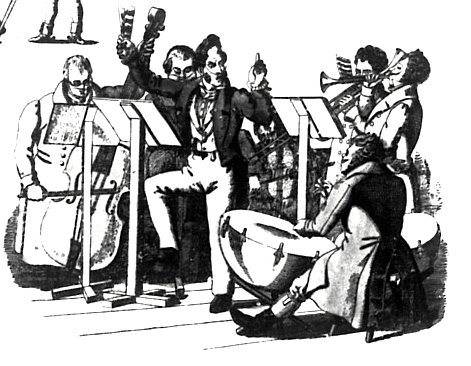
1835-67—Paris, France: Antoine Dieppo serves as solo trombonist of the Opéra orchestra (Sluchin, Slide Trombone).
c. 1836—Antoine Dieppo’s Méthod complete pour le trombone, an early method book for trombone (Wallace, Brass Solo 240).
c. 1836—Lyon, France: A trade-card depicting the Distin Family Brass Quintet, an ensemble known for adopting Adolph Sax’s valve instruments, includes a member holding a slide trombone, indicating the instrument was probably used at least during the early days of the ensemble (Baines, Brass plate XI). According to Dudgeon, “The early quintet performances of the Distin family used various combinations of keyed bugle, cornopean, slide trumpet, natural horns, and trombone; all made by the firm of Pace. By 1844, the Distins met Adolph Sax and made the switch to valved saxhorns” (Dudgeon, Keyed Bugle 28).
1836-71—Paris, France: Antoine Dieppo runs the trombone studio at the Paris Conservatory (Dudgeon 195).
1837—Johann Baptist Lachmüller’s print, Bamberg Maskerede, features 2 different rear-facing trombones (see below image; public domain). Special thanks to Tassos Dimitriadis.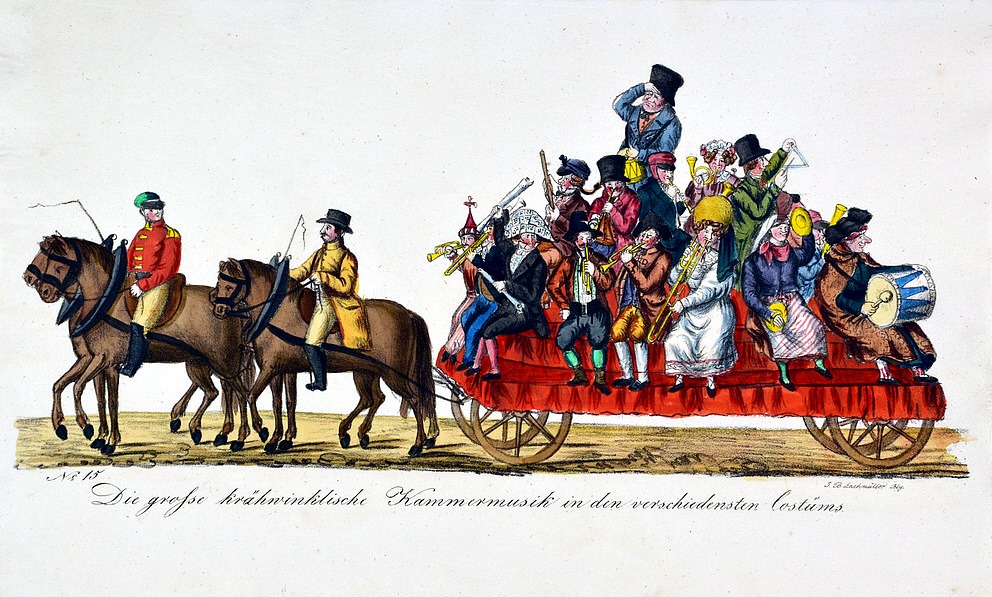
1837—Stuttgart, Germany: the Stuttgart Court Opera contains 3 trombones (Herbert, Trombone 334).
1837—Leipzig, Germany: Carl Queisser performs the Müller Concertino at the Gewandhaus.
1837—New Orleans, Louisiana: Popular trombonist Felippe Cioffi teams with trumpeter Alessandro Gambati to perform a transcription of the duet from Bellini’s Norma. A visiting newspaper reporter declares, “We have heard them once and shall never forget their heavenly music” (Kmen 211).
1837—Hector Berlioz writes Messe des Morts, a requiem which is one of the earliest works by a major composer to call for trombone pedal notes (the earliest known example is actually Hérold’s Zampa, 1831). Berlioz later remarks that “although at the first rehearsal of this work five or six of the eight trombone players exclaimed with indignation that this was impossible,” they were able to get the notes to sound “quite full and pure—played by artists who did not believe in the existence of these notes” (Burton 173). Berlioz includes the following sentence in the score: “These notes are on the instrument and the players must get them out” (Gregory 60). Regarding this passage, Cecil Forsyth, who had never heard it, later says, “It probably sounds very nasty,” to which Gordon Jacob responds, “The present writer has heard the passage. It does!” (Macdonald 217). The requiem, which calls for 16 trombones, is premiered at the entombment of General Charles de Damremont (Chase 245).
1837—Hector Berlioz hears the true bass trombone, probably for the first time, when Johann Strauss, Sr. brings his Viennese orchestra to Paris. Berlioz notes that the instrument is “full, rich and powerful in effect.” He calls for a true bass trombone only once in his own compositions: the Symphonie funebre et triomphale, where he labels it “grand trombone bass” but marks the part “non oblige,” possibly because there are no available players in Paris (Macdonald 213).
1837—Leipzig, Germany: Ferdinand David writes his Concertino for trombone for Carl Queisser, principal trombonist with the Gewandhaus Orchestra. David is concertmaster of the same orchestra (and Felix Mendelssohn is conductor). The concertino is originally a violin work consisting of only the slow movement; the outer movements are added later by the composer. The review of the premiere by Queisser at the Gewandhaus says, “New work by F. David was performed by Mr. Queisser and was of appropriate dignity for the instrument” (Lewis, Gewandhaus).
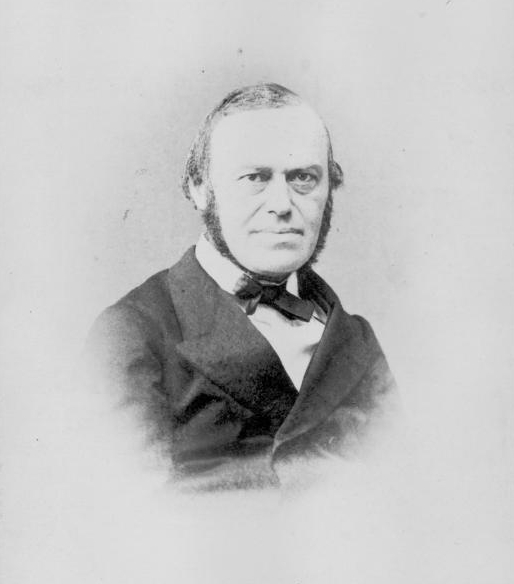
Ferdinand David (1810-1873). Photo from collection Manskopf, UB Frankfurt, http://edocs.ub.uni-frankfurt.de/volltexte/2003/7800324/
https://www.youtube.com/watch?v=CNlM598hkeg
1837—Samuel Vale as Timotheus Trombone in “The Battle of Sedgemoor,” an engraving by G. Adcock, after a painting by R.W. Buss, portrays an actor with trombone. The actor, Samuel Vale, lived from 1797 to 1848 (see below image; public domain) (source: www.artstor.org).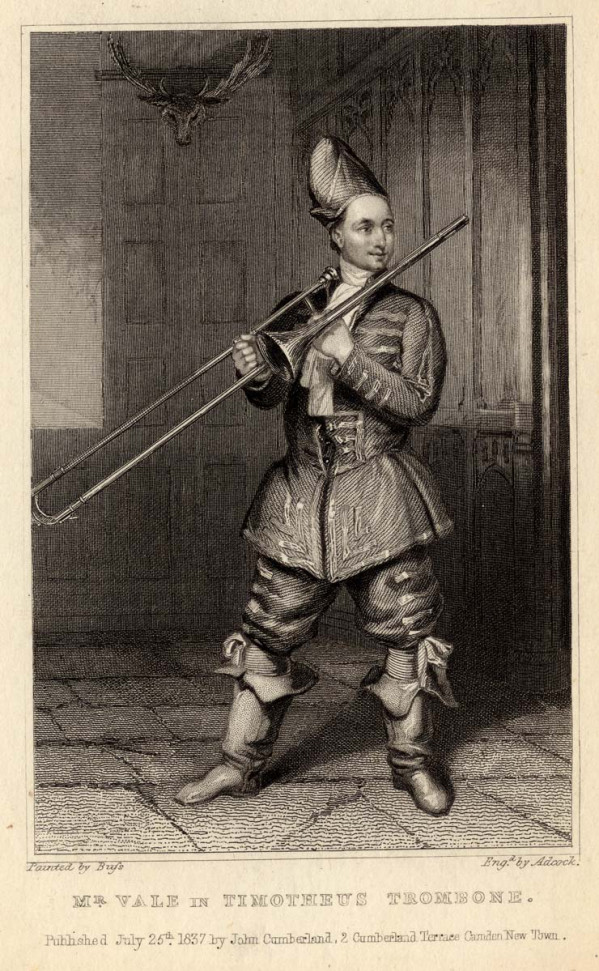
c. 1838—Merthyr Tydfil, Wales: The earliest collection of brass band music originates. Written for the Cyfarthfa Band, it includes trombone parts (Herbert, Brass Bands 183).
c. 1838—Bergamo, Italy: Giovanni Simone Mayr complains about the overuse of trombone in his brief orchestration treatise, Trattatella sopra agli stromenti ed instromentazione: “If in Semiramide the trombone part fills 20 pages; if this strong imposing instrument must, like a second violin, imitate the bass in eighth-notes; if every solo in the ballet must be accompanied by three trombones; then this very instrument has lost every importance, and we can only restore that to it by employing it rarely, and never solely as a means to generate noise. Rather, I would permit one bass trombone to reinforce the bass line, and mark it, since the majestic perfect chord should only appear thus and proceed slowly. Otherwise, how could the spirit of the Commendatore in Don Giovanni speak, [or] how should we make heard the voice of Thanatos to Alceste?” (Mayr 289).
1838—L’Enragé Musicien, a lithograph by Bourdin after an image by Robert William Buss, depicts a trombone player practicing in the middle of the night (the clock shows 2:30), with neighbors protesting and a scowling portrait of Handel looking on. The trombonist plays on an instrument with a slide extension handle (see below image; public domain) (Goodfriend, Prints and Drawings of Musical Interest).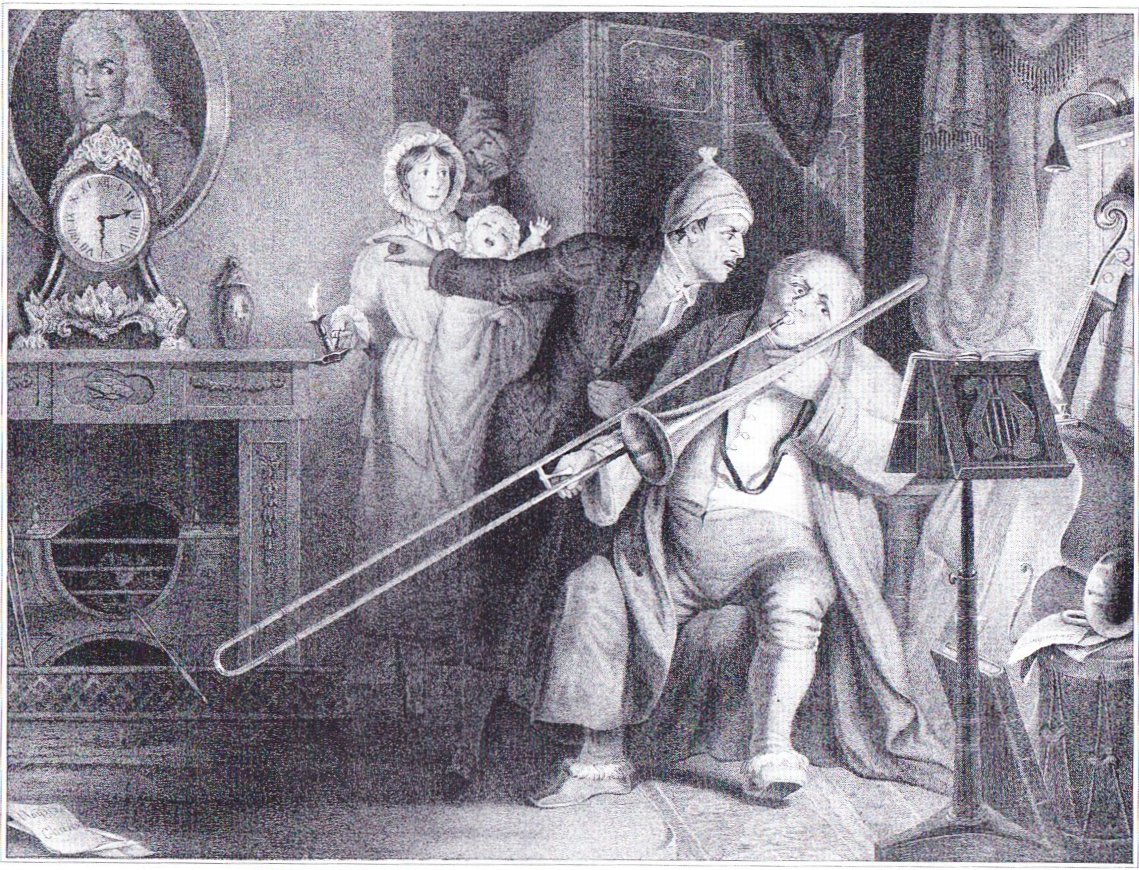
Below is the original painting, “The Musical Bore,” by Robert William Buss (public domain; special thanks to Brian Haapanen).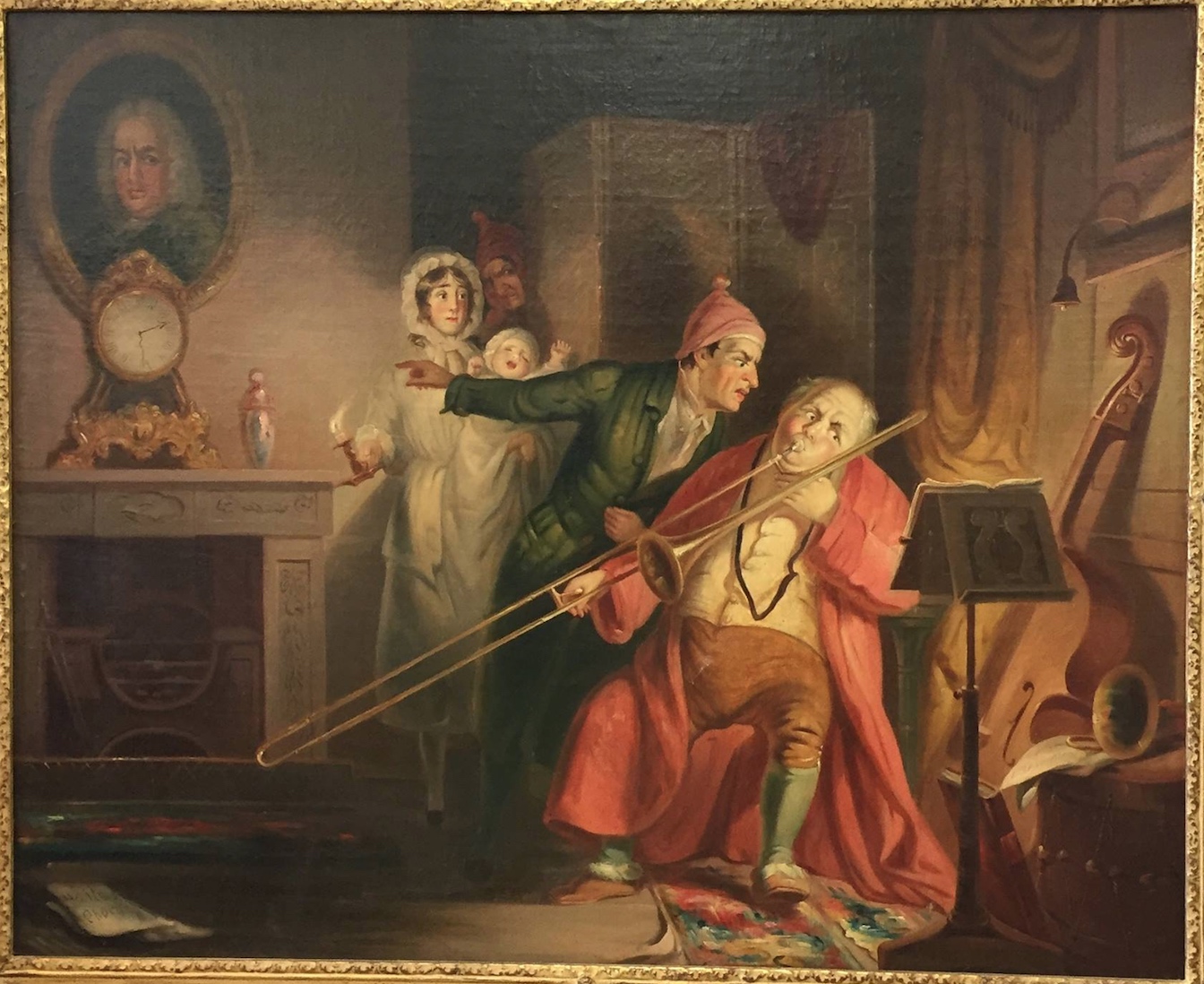
Although my source for the top image (the lithograph) indicates that the lithograph is after the painting by Robert William Buss, below is a painting by Carl Zimmerman (according to this auction house) that is almost identical to the other 2 images—except the time appears to be 1:30 instead of 2:30 (see below image, click to enlarge; public domain). It may be a copy by Zimmerman of Buss’s painting.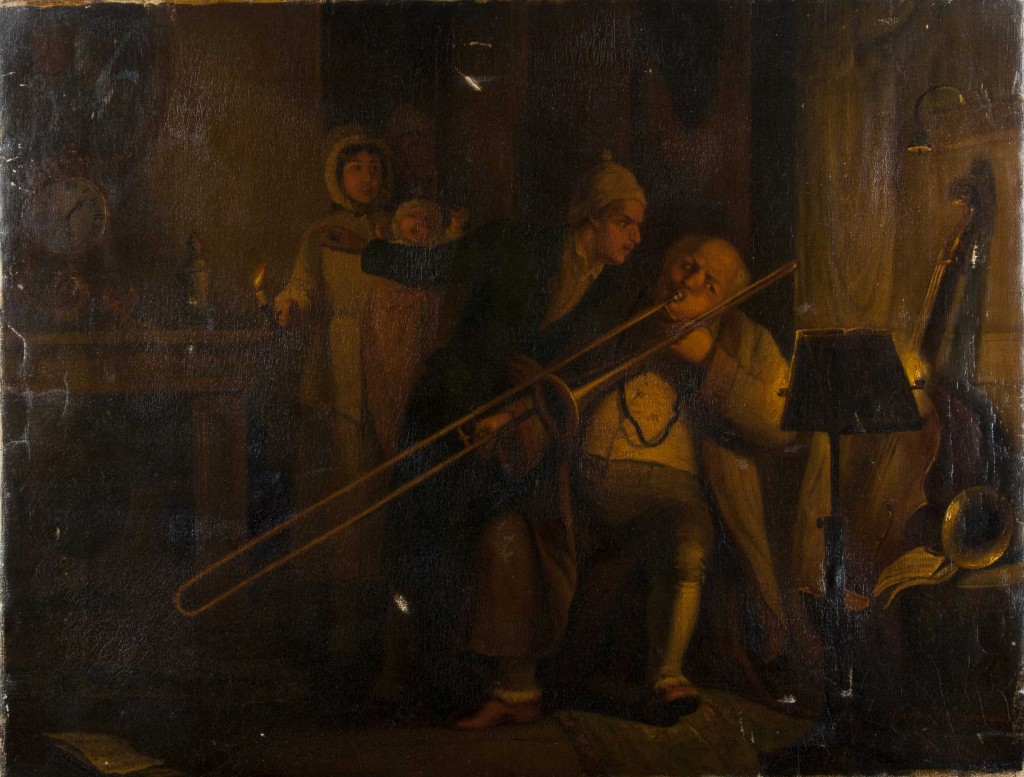
Another engraving after the Buss painting, this one by Carl Mayer, dates from c. 1850 (see below image; public domain) (special thanks to Tassos Dimitriadis).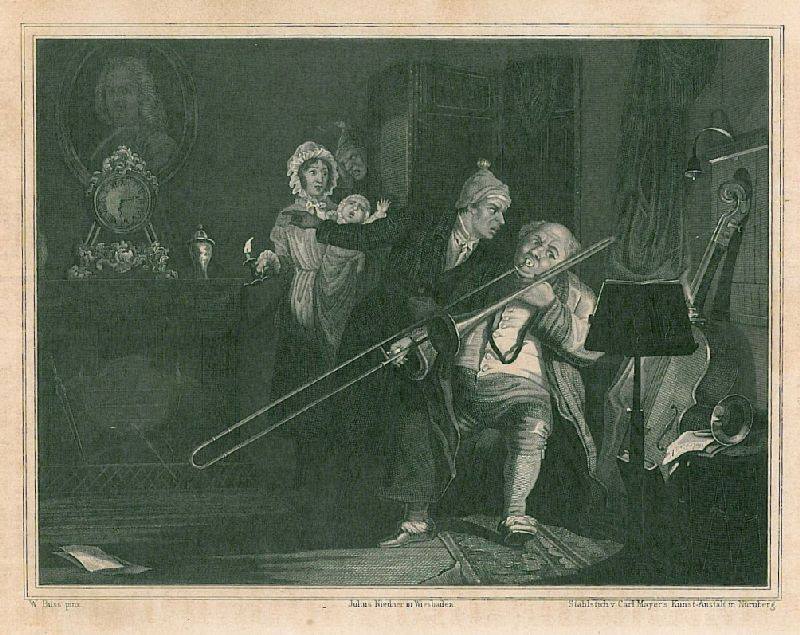
A painted snuffbox from around the same time period follows the same basic image as the 4 above (see below image; public domain) (source: Europeana, Museum Rotterdam).
Finally, Man Playing and Keeping Others Awake, a French tissue stereocard marked B.K. Photos and J.M., appears to be something of a loose photographic re-creation of the painting by Robert William Buss. It dates from 1862-65 (see below image; public domain).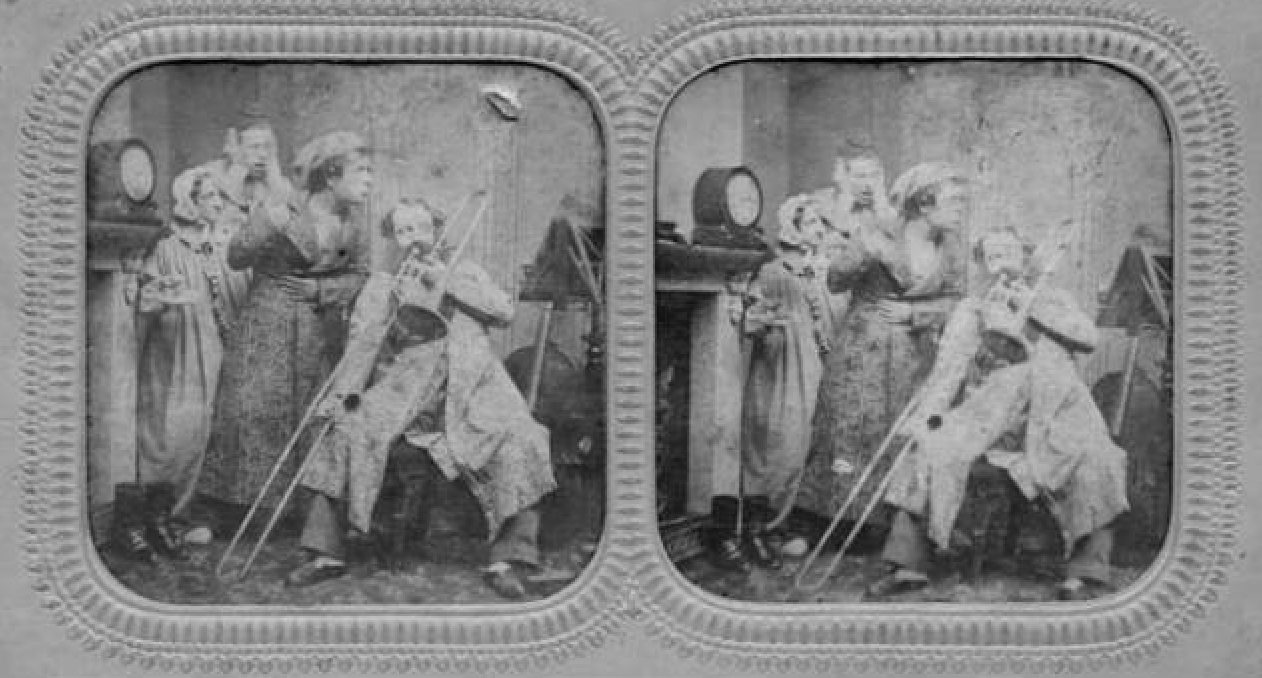
1838—Germany: The Rudolstadt Court Orchestra contains 3 trombones (Herbert, Trombone 334).
1838—Leipzig, Germany: Carl Queisser performs the David Concertino at the Gewandhaus.
1838—Paris: Musicians, an engraving by Lemaitre after The Triumph of Maximilian, features 2 trombone players (see below image; public domain).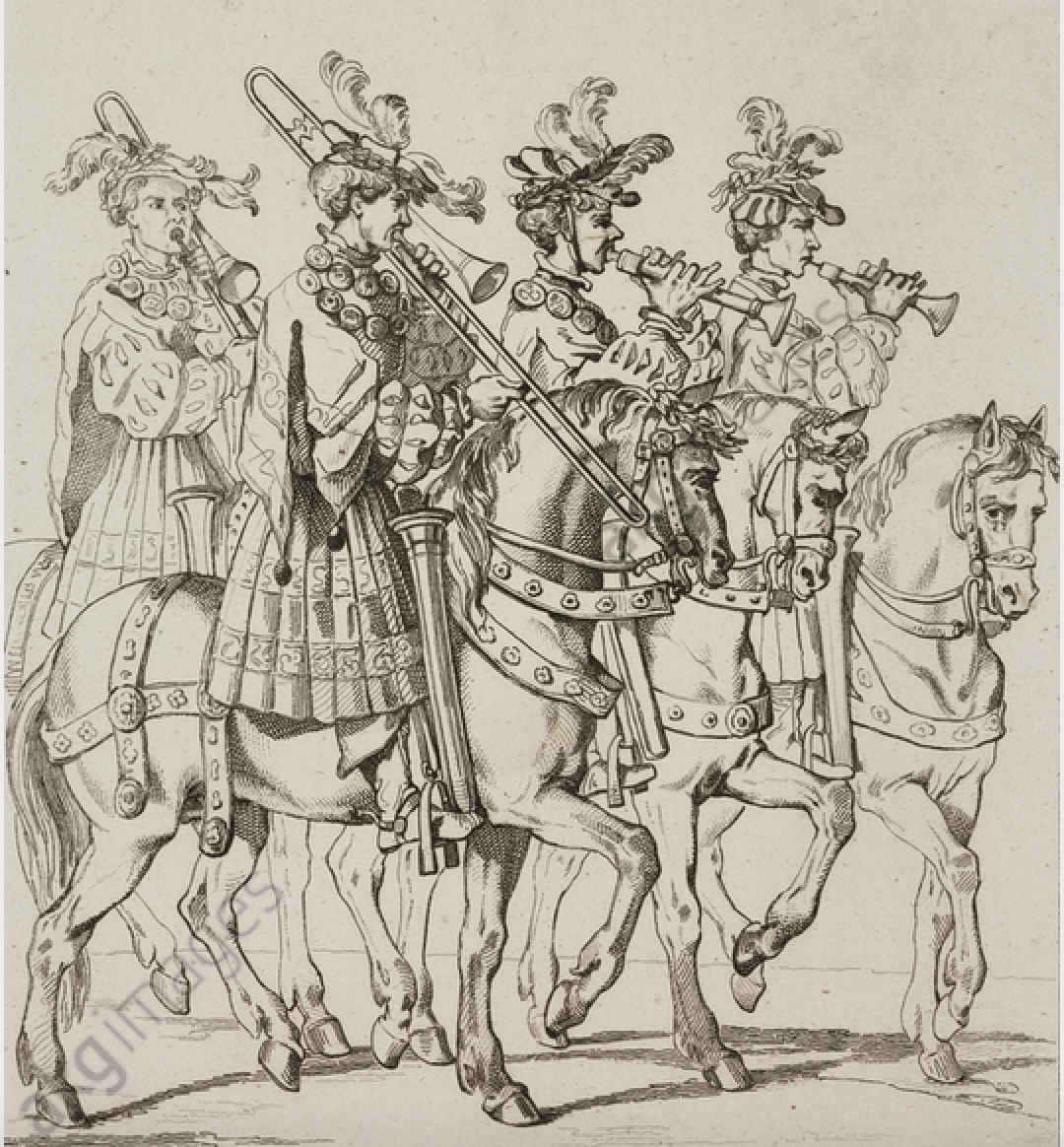
1838-67—Paris, France: Antoine Dieppo serves as solo trombone with the Société des Concerts du Conservatoire (Sluchin, Slide Trombone).
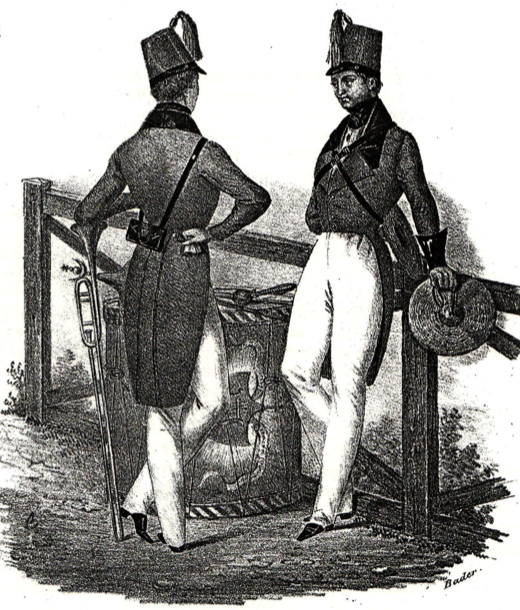 c. 1839—Fribourg, Switzerland: Musica militaris, a print depicting musicians of the boarding school of Fribourg, features a percussionist and a trombonist with a rear-facing bell (see facing image; public domain) (Bovet and Curchod 28). For a similar image from Belgium, see 1831, above.
c. 1839—Fribourg, Switzerland: Musica militaris, a print depicting musicians of the boarding school of Fribourg, features a percussionist and a trombonist with a rear-facing bell (see facing image; public domain) (Bovet and Curchod 28). For a similar image from Belgium, see 1831, above.
1839—Frankfurt, Germany: In a collection of scores for wind band, a 119-page manuscript score of C. Ostreich’s Simphonia für Blasinstrumente includes parts for alto trombone, tenor trombone, and bass trombone (Dudgeon, Keyed Bugle 41).
1839—Félicien David writes Nonetto in C minor and Nonetto in F major (now lost) for 2 cornets a pistons, 4 cors a pistons, 2 trombones, and ophecleide (Wallace, Brass Solo 240).
1839—London, England: Her Majesty’s Theatre contains 3 trombones (Herbert, Trombone 334).
1839—Paris, France: The following 4 people are listed as trombonists in the Opéra Comique: “Carteret (alto), Buisson (alto et ténor), Marchal (ténor et basse), Marez (ditto)” (Carse, Orchestra 493).
1839—Leipzig, Germany: The F rotary valve attachment is invented by instrument maker C. F. Sattler. It is initially only used for bass trombones (Gregory 85).
1839—London, England: A lithograph by George Scharf (the elder) entitled London Street Band includes a trombone (see below image; public domain).
c. 1840—Joseph Novakowsky, Concertino for Trombone and Piano. Novakowsky (1805-1865), a famous Polish piano virtuoso, had played trombone in his student days. This work was published posthumously by Fischer as both Theme and Variations and Concertino.
c. 1840—J. C. Kuhne, Concertino for Trombone and Piano. Kuhne, a German composer from Erfurt, had likely come into contact with well-known soloist Carl Queisser.
c. 1840—Paris, France: A “buccin trombone” with a dragon-head bell is manufactured. The instrument is now held in the Edinburgh University Collection (Bevan 46).
c. 1840—Holland: A lithograph depicting a lively Dutch house concert, from a drawing by David Joseph Bles (1821-1899), incudes a trombonist (see below image; public domain). Click on image to expand.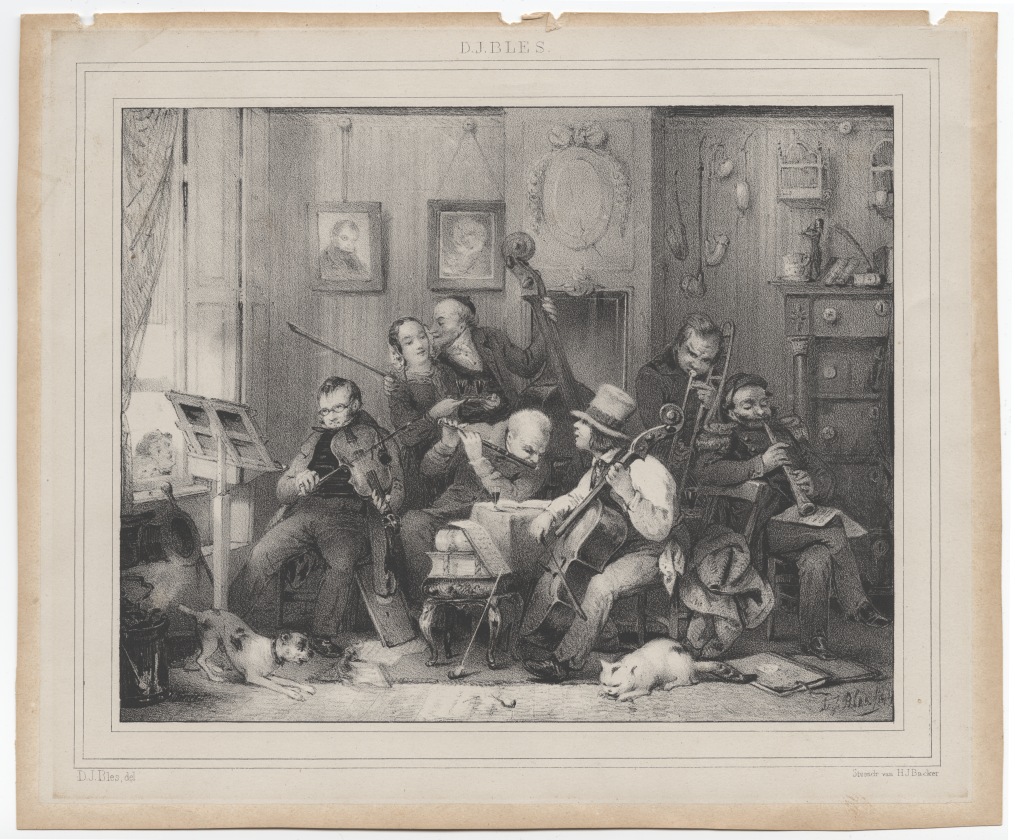
c. 1840—Friedrich Kaiser depicts an aristocratic dance in his lithograph, Geschlossene Gesellschaft (Closed Society). A trombone pokes over the edge of the balcony, where the orchestra is playing (see below image; public domain) (Salmen, Tanz im 19 114). Click on image to expand.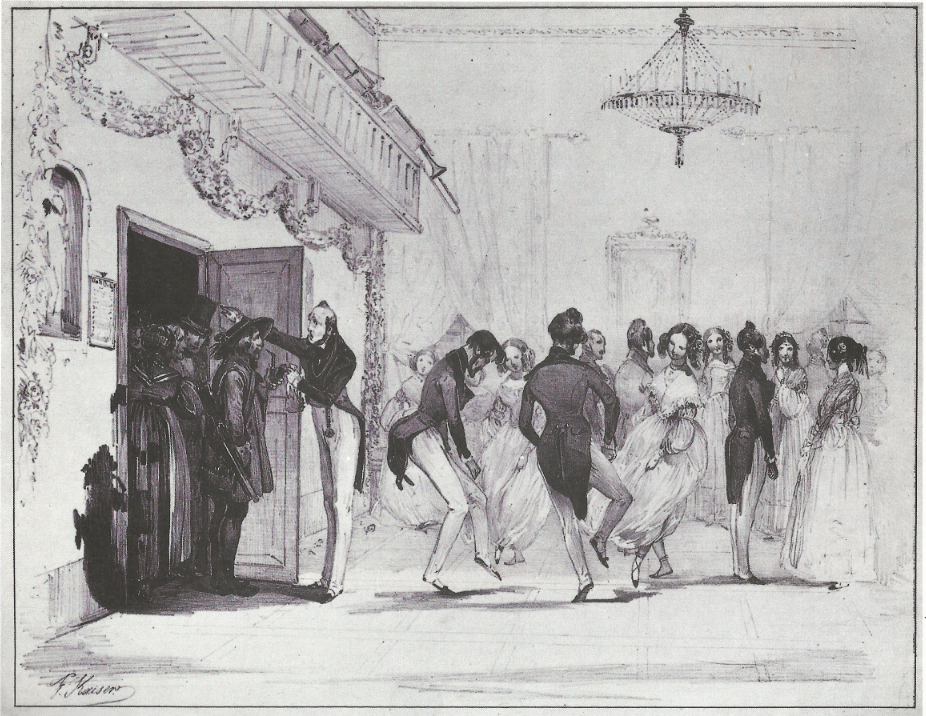
1840s— Minas Gerais, Brazil: American clergymen Kidder and Fletcher visit a plantation called “Soldade,” where a slave orchestra that includes trombones performs “an overture to some opera,” and a Latin mass “with admirable skill and precision.”
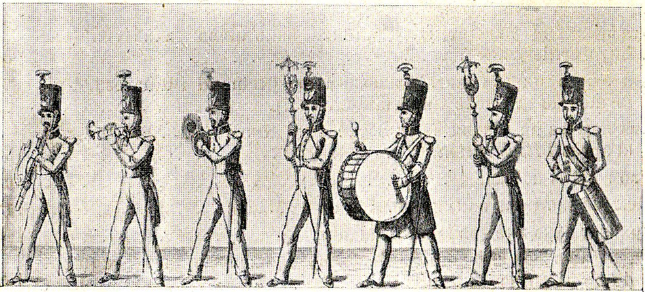 1840—France: A print depicting a Napoleonic military band includes what could be a buccin-style trombone (dragon-head bell) (see far left of above image; public domain) (Brenet 125). For a similar image, see 1804-1815, above.
1840—France: A print depicting a Napoleonic military band includes what could be a buccin-style trombone (dragon-head bell) (see far left of above image; public domain) (Brenet 125). For a similar image, see 1804-1815, above.
1840—Leipzig, Germany: Carl Queisser performs the David Concertino and Müller Concertino at the Gewandhaus.
1840—Paris, France: The Conservatoire Orchestra contains 3 trombones (Herbert, Trombone 334).
1840—Hague, The Netherlands: The Hague Royal Orchestra contains 3 trombones (Herbert, Trombone 334).
1840—New Orleans, Louisiana: Popular trombone soloist Felippe Cioffi is featured at the Vauxhall Gardens. As the local newspaper, The Bee, remarks, one can go to the gardens for “ice creams and songs, soda water and Cioffi’s trombone” (Kmen 212).
1840—Donizetti’s opera, La favorita, features a technically challenging trombone obbligato.
1840—Stuttgart, Germany: In a late example of Stadtpfeifer activity, French composer and musicologist Jean Georges Kastner hears Stadtpfeifer consisting of a cornett and 3 trombones play a chorale each day from a balcony in Stuttgart (Dickey, The Cornett 67).
1840—Paris, France: Hector Berlioz, Symphonie Funebre et Triomphale. The 2nd movement, “Recitative and Prayer,” is a trombone solo—the most extensive in the orchestral literature. It was composed for Antoine Dieppo, teacher at the Paris Conservatory (Wallace, Brass Solo 241).
1840—Epinal, France: An engraving entitled Musique d’Amateurs, published by Pellerin, features 3 trombones among 27 figures with various musical instruments. One of the trombones is a buccin, or dragon-bell instrument (see below image; click picture for larger version; public domain).
1841—Germany: The Coburg Court Orchestra contains 3 trombones (Herbert, Trombone 334).
1841—Leipzig, Germany: Carl Queisser performs a new work, Ferdinand David’s Concerto Militaire, at the Gewandhaus (Lewis, Gewandhaus).
1841—Paris, France: Hector Berlioz, in a review of Montfort’s opera-comique La jeunesse de Charles-Quint, complains about contemporary use of the trombone: “The craze for the bass drum began to recede a few months ago, but the trombone craze is on the rise. Just when we were learning to admire the magnificent orchestration of Der Freischütz, where Weber uses the trombones only three or four times and with remarkable reserve, those hounds started barking, howling and bellowing at the Opéra Comique in the middle of a love duet or a comic ensemble.” Berlioz goes on to fault a Mass by Dietsch for “using trombones to reinforce the orchestra without any regard for their tone, which disqualifies them from the appropriate style of so many pieces. Let them mutter a solemn prayer in the Kyrie or blaze away with fanfares in the Iterum venturus, but…. So this is where the art of instrumentation now stands! If hearing the chorus of furies in Iphigénie en Tauride or the entrance of the Commendatore in Don Giovanni or the nuns’ orgy in Robert le diable, would you not? But no, it is M. Petipa or M. Mabille stepping on stage to dance a… pas de deux…. At the Opéra Comique an old chap is upset at losing his snuffbox—three trombones! He rejoices when he finds it—three trombones! A blind man drinks a glass of cheap wine—three trombones! A stable lad tightens some layabout’s belt—three trombones! Every time!” (Macdonald 225).
1841—New Orleans, Louisiana: Trombonist Felippe Cioffi, one of the most popular and frequent soloists in the active musical environment of New Orleans, is declared by newspaper The Picayune to be “incomparably the best trombone player in America, and we have been told in the world” (Kmen 211).
1841—Robert Schumann’s Symphony No. 1 (Spring) utilizes trombones independently, including a solo chorale in the second movement.
1841—Robert Schumann’s Symphony No. 4 is premiered in Leipzig and calls for 3 trombones. A revised version is performed for the first time in 1853.
1841—Germany: Festzug des Veteranenvereins (Veterans Association Parade) includes a rear-facing trombone (see below detail; public domain).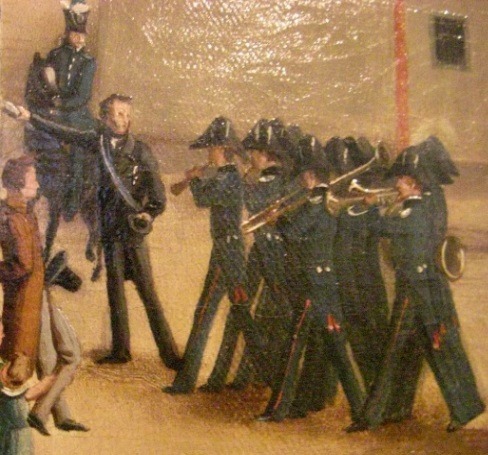
1842—Vienna, Austria: The Vienna Philharmonic Orchestra contains 4 trombones (Herbert, Trombone 335).
1842—Vienna, Austria: The Vienna Court Opera contains 4 trombones (Herbert, Trombone 335).
1842—London, England: 3 trombonists are included in the subscription evening concerts at the Hanover Square Rooms and the London Tavern (Carse, Orchestra 492).
1842—Paris, France: Luigi Cherubini’s Requiem in D Minor, which requires 3 trombones, is performed at his funeral (Chase 193).
1842—Stuttgart, Germany: Berlioz, on a tour of Germany, visits Stuttgart, where he is particularly impressed with Schrade, a trombonist in their orchestra. Berlioz says, “The trombones [in Stuttgart’s orchestra] are extremely good. The first, Schrade, who was in the Vivienne concert orchestra four years ago, is a most gifted player, a complete master of his instrument who makes light of the most formidable difficulties and produces a magnificent tone from the tenor trombone—I should rather say tones, for by some process not yet explained he can play three or four notes at the same time, like the young horn-player whom the musical Press of Paris has been so taken up with lately. During a fantasia which he performed at a public concert in Stuttgart, Schrade paused at a pedal point and to the astonishment of all present sounded simultaneously the four notes of the chord of the dominant seventh in the key of B flat, pitched as follows: E flat, A, C, F. It is for the acousticians to account for this new phenomenon of natural resonance and for us musicians to study it and profit by it if the occasion arises” (Berlioz-Cairns 276).
1842—Hechingen, Germany: Berlioz, on a tour of Germany, visits Hechingen, where an orchestra is assembled that includes several strong players, but a brass and percussion section that leaves something to be desired. He says, “As to the trumpets, the trombone (there is only one) and the timpanist, whenever they play they make you wish you had asked them not to; their incapacity is total.” Berlioz proceeds with the concert, however, adapting several of his works to a scaled-down orchestra. He says the following about the trombonist’s performance: “The solitary trombone was left to his own devices; but as he wisely confined himself to the notes with which he was thoroughly familiar, such as A flat, D and F, and was careful to avoid all others, his success in the role was almost entirely a silent one” (Berlioz-Cairns 281).
1842—Mannheim, Germany: Berlioz, on a tour of Germany, visits Mannheim, where he is forced to change his program because of the orchestra’s trombones. In his Memoirs he says, “I remember only that I wanted to give my second symphony (Harold) complete but that at the first rehearsal I had to suppress the finale (the Orgy) because the trombones were manifestly unequal to it.” A valve trombone is also adapted as a substitute for ophicleide: “There is no ophicleide; Lachner [the regular conductor] had attempted to devise a substitute for this instrument, which is used in all modern scores, by having a valve trombone made with a compass extending to bottom C or B. In my opinion it would have been simpler to send for an ophicleide and much better from the musical point of view, as the two instruments have little in common” (Berlioz-Cairns 288).
1842—London, England: Curious Inns and Outs, a political satire lithograph by John Doyle, includes a man playing trombone (see below image; public domain).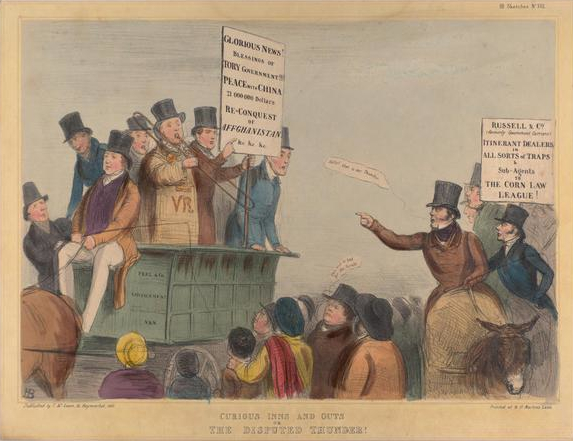
1842—Leipzig, Germany: Berlioz, on a tour of Germany, visits Liepzig. He reports in his Memoirs that “the ophicleide, or rather the meager brass object masquerading under that name, bore no resemblance to the French variety, having practically no tone,” so it was “replaced, after a fashion, by a fourth trombone” (Berlioz-Cairns 300).
1842—Berlioz, in his Memoirs, remarks, “Repeated observations at Berlin led me to think that the best way of grouping the trombones in the theatres is, after all, that adopted at the Paris Opéra, where three tenor trombones are employed” (Carse, Orchestra 410).
1842—Dresden, Germany: The court orchestra, where Franz Schubert is vice-concertmaster, includes the following 3 trombonists: Gottschalk, Rühlmann, and Queissert (Carse, Orchestra 488).
1842—Paris, France: First Paris Conservatory morceau de concours: Antoine Guillaume Dieppo, Solo.
1842—New York: First season of New York Philharmonic. Original trombone section includes Tom Dodworth, W. Plain, and C. Schutz. Compensation for first season is $25.00 per player. Tom Dodworth is 1 of 3 from his family in original NY Philharmonic and is also a member of the well known Dodworth Band, a military-style band that played for the inaugurations of three US presidents—Van Buren, Harrison, and Tyler (Shanet 8, 91).
1842-43—Manufacture date of an alto trombone in E-flat, labeled “C. W. Moritz/ Königl.-Hof Instrumentenmacher, Friedrichsgracht No 50 in Berlin” (Kölnisches Stadtmuseum 252).
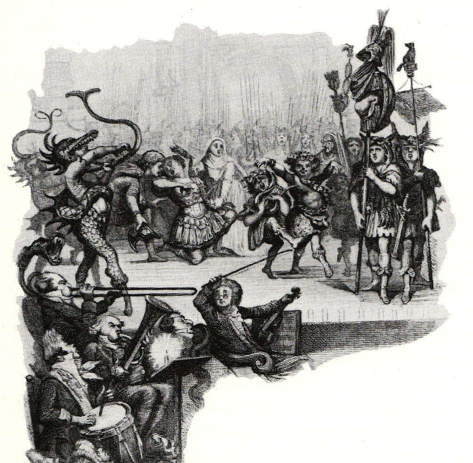 1843—France: A depiction of a theatre orchestra includes a prominently-positioned dragon-bell trombone (buccin). The image is printed in “La Parodie de la Vestale,” Chants et Chansons Populaires de la France II, 1843 (see facing image; public domain) (London, British Library; Remnant, Musical Instruments of the West 216).
1843—France: A depiction of a theatre orchestra includes a prominently-positioned dragon-bell trombone (buccin). The image is printed in “La Parodie de la Vestale,” Chants et Chansons Populaires de la France II, 1843 (see facing image; public domain) (London, British Library; Remnant, Musical Instruments of the West 216).
1843—Madrid, Spain: A dragon-bell trombone (buccin) is made by manufacturer José Ramis (Heyde, Metropolitan).
1843—Berlin, Germany: The Berlin Opera contains 4 trombones (up from 3 in 1825) (Herbert, Trombone 335).
1843—Frankfurt, Germany: The Frankfurt Opera contains 3 trombones (up from 1 in 1821) (Herbert, Trombone 335).
1843—Leipzig, Germany: Carl Queisser performs the David Concertino and Müller Concertino at the Gewandhaus (Lewis, Gewandhaus).
1843—Vienna, Austria: Michael Beheim writes, “There was also the custom,/When a large cannon was around,/That with the same arms they would shoot a round/Just as in the town there were/Trombones and trumpets./And also the loud noises of timpani,/Which resounded throughout the town,/And when the sound was over,/Then from the house/They discharged their rifles./This was done a great deal” (Bowles, Timpani 356).
1843—Paris, France: Paris Conservatory morceau de concours: Hyacinthe Eleonore Klosé, Air varié.
1843—Dresden, Germany: Hector Berlioz conducts his Symphonie funebre et triomphale in Dresden. He sends a message to Antoine Dieppo, the French trombonist for whom the second movement solo was written, saying that he had not found Dieppo’s equal, and that German trombonists had given him “chest-ache, not to mention ear-ache” (Macdonald 227).
1843—Berlin, Germany: Hector Berlioz visits Berlin, where he hears 2 bass trombones in the opera orchestra. Complaining that there are none in Paris, he says, “Parisian musicians refuse to play an instrument that is so tiring to the chest. Prussian lungs are evidently more robust than ours.” He is not, however, impressed with the balance of the trombone section there; he reports: “Their combined volume of tone is so great as to obliterate the alto and tenor trombones playing the two upper parts. The aggressive tone of one bass trombone would be enough to upset the balance of the three trombone parts as written by composers nowadays. But there being no ophicleide at the Berlin Opera, they give the part to a second bass trombone. The effect of having two of these formidable instruments one above the other (the ophicleide part being frequently written an octave below the third trombone) is disastrous. You hear nothing but the bottom line; even the trumpets are all but drowned. When I came to give my concerts I found that the bass trombone was much too prominent—although in the symphonies I was using only one—and had to ask the player to sit so that the bell of the instrument was facing into his stand, which acted as a sort of mute, while the alto and tenor trombonists stood up to play with their bells pointing over the top of their stands. Only in this way could all three parts be heard” (Macdonald 213).
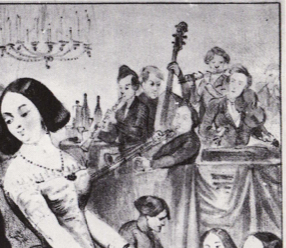
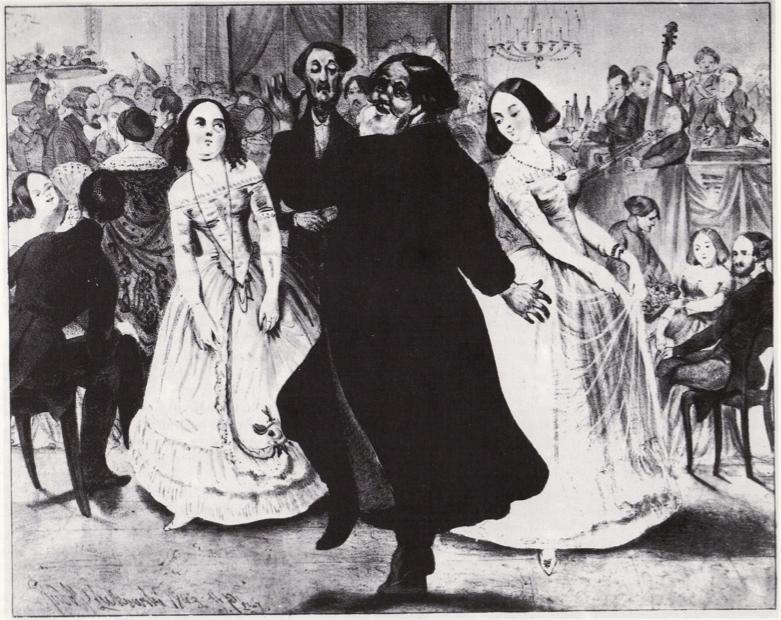 1843—Russia: A lithograph by Rudolf Joukowsky titled Kosakentanz depicts a lively “Cossack Dance.” The orchestra providing the music includes what appears to be a trombone with a slide extension handle (see facing detail and image below; public domain) (Berlin, Archiv für Kunst und Geschichte; Salmen, Tanz im 19 75).
1843—Russia: A lithograph by Rudolf Joukowsky titled Kosakentanz depicts a lively “Cossack Dance.” The orchestra providing the music includes what appears to be a trombone with a slide extension handle (see facing detail and image below; public domain) (Berlin, Archiv für Kunst und Geschichte; Salmen, Tanz im 19 75).
1843—Hudson, Ohio: An advertisement in the Ohio Observer labeled simply “Boston,” (though offering a Cleveland street address) mentions numerous musical instruments for sale, including “Alto & Tenor Trombone” (Ohio Observer).
1844—Milan, Italy: Fermo Bellini’s Teoriche musicali discusses the use of trombone with ophicleide: “The modern custom, adopted by some composers, of forming a quartet consisting of three trombones and an ophicleide does not seem very sensible, given that the tone colour of the trombones, so dominant and in high relief, is very different from that of the ophicleide; it would be better for this instrument to double the bottom line, or else to find some way to give the trombones a good cantabile bass whenever they are on their own” (Meucci).
1844—Vienna, Austria: The Concert Spirituel orchestra contains 3 trombones (Herbert, Trombone 335).
1844—Vienna, Austria: The Imperial Orchestra contains 2 trombones (Herbert, Trombone 335).
1844—Munich, Germany: The Munich Court Opera contains 3 trombones (Herbert, Trombone 335).
1844—Boston, Massachusetts: Simon Knaebel publishes brass quartet arrangements for 2 bugles in B-flat, trombone, and ophicleide in Keith’s Collection of Instrumental Music (Dudgeon, Keyed Bugle 173).
1844—France: Famous caricaturist Jean-Ignace-Isidore Gérard (also known as J. J. Grandville) publishes a caricature entitled Melody for 200 Trombones. A parody of perceived overuse of brass in contemporary music, it depicts 2 longs lines of trombonists. The caption instructs that the piece be played “with fire, fortissimo, repeated 300 times, then louder still” (public domain image) (Thomson 61).
1844—Paris Conservatory morceau de concours: Louis Stanislas Xavier Verroust, Solo.
1844—Paris, France: Kresser’s 12 Quatuors pour quatre Cornets a pistons is scored for 4 cornets or 3 cornets and alto trombone. The partbook for the lowest part is marked “Piston ou Trombon[one] alto a Pistons en Mi.” The composer’s first name is not known, although the title page of the collection states that he was a trumpeter in the Académie Royale de Musique, professor at the Gymnase Musical Militaire, and a member of the Société des Concerts in Paris (Kresser).
1844—Paris, France: The first edition of Hector Berlioz’s orchestration text, Grand traité d’ instrumentation et d’ orchestration medernes, is published. The section on trombone demonstrates detailed knowledge of the instrument; later commentators suspect that he had “inside help” on the section, perhaps from Antoine Dieppo, trombone teacher at the Conservatory and one of the leading trombonists of the age (Macdonald xxix).
1844—Hector Berlioz writes, “In my opinion, the trombone is the true head of that family of wind instruments which I have named the epic one. It possesses nobility and grandeur to the highest degree; it has all the serious and powerful tones of sublime musical poetry, from religious calm and imposing accents, to savage, orgiastic outbursts. Directed by the will of a master, the trombones can chant like a choir of priests, threaten, utter gloomy sighs, a mournful lament or a bright hymn of glory. They can break forth into awe-inspiring cries, and awaken the dead or doom the living with their fearful voice.”
1844—Hector Berlioz, in his orchestration textbook, includes 4 alto trombones, 6 tenor trombones, and 2 bass trombones in his “dream orchestra” (Macdonald 329).
1844—Hector Berlioz, writing about trombone, says, “Nevertheless, ways were found some thirty years ago to degrade this instrument by limiting its use to the worthless and ridiculous doubling of the double-bass part. Fortunately, this method has now been almost completely abandoned…”
1844—Hector Berlioz, speaking of slide trombone, says, “It is the best of all without question. It has a full and strong sonority, it can perform rapid passages which are unplayable on the bass trombone and its timbre is good in the totality of its register.”
1844—Hector Berlioz says, “The sound of the bass trombone is majestic, formidable and frightening. It has the right to the low part within the mass of the brasses. Unfortunately, we haven’t any in Paris, it is not taught in the Conservatory and no trombonist, until now, takes it seriously.”
1844—Hector Berlioz says, “One often writes singing solos for the valve alto trombone. A well phrased melody can thus have a lot of charm. But it is an error to think that when given to a real virtuoso it would be less charming on the slide trombone. This was proven successfully many times by M. Dieppo.”
1844—Hector Berlioz, makes the following interesting observation in his orchestration textbook about use of trombone with harp: “On their own [harps], or in groups of two, three or four, they are also felicitous in effect combined with the orchestra or accompanying vocal or instrumental solos. Of all known timbres it is odd that horns, trombones and brass instruments in general blend best with harps (Macdonald 73).
1844—Hector Berlioz, in his orchestration treatise, speaking of the tenor trombone’s upper register, calls the notes c and d-flat “difficult.” In the 1855 edition he revises this, calling only the d-flat difficult (Macdonald 211).
c. 1845—A lithograph by respected German artist Heinrich Maria von Hess (1798-1863) portrays a short trombonist (see below image; public domain) (German National Museum, Nuremberg).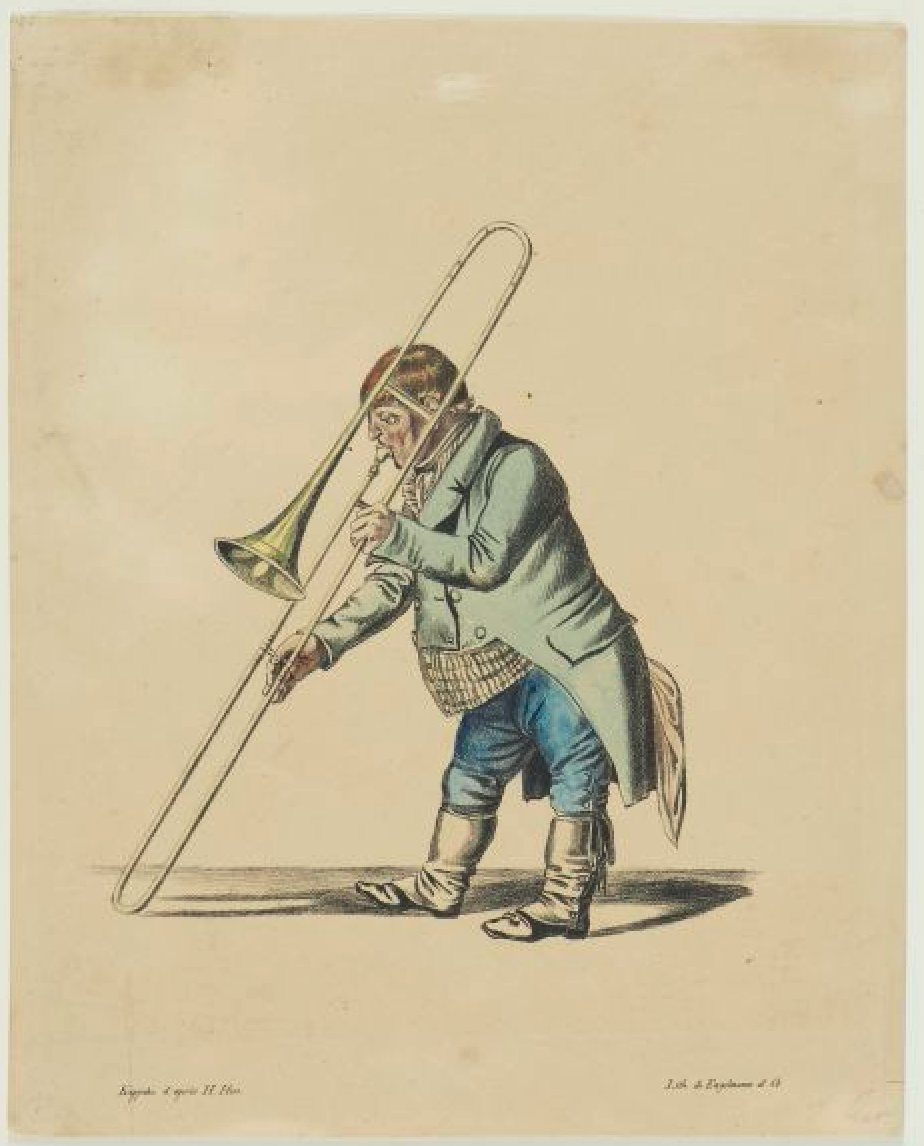
c. 1845—Paris, France: Hartman’s Methode Elementaire de Trombone includes an illustration of a military trombonist. “Hancké” is listed at the bottom of the print (see below image; public domain).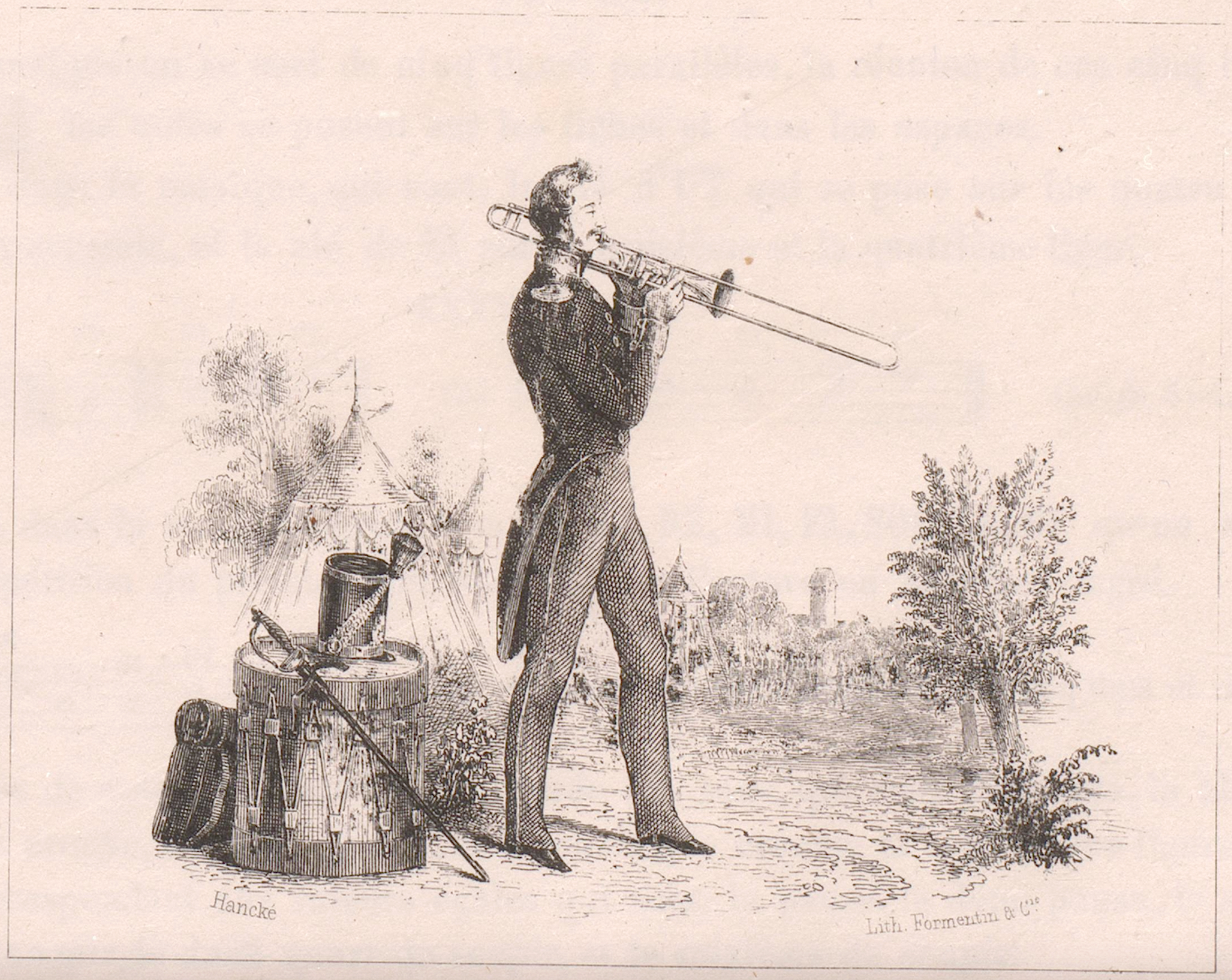
c. 1845—Paris, France: An illustration by Charles Vernier, Uniforms of the French Army, Musicians, includes a depiction of a military trombonist (see below image; public domain) (Mardaga 119).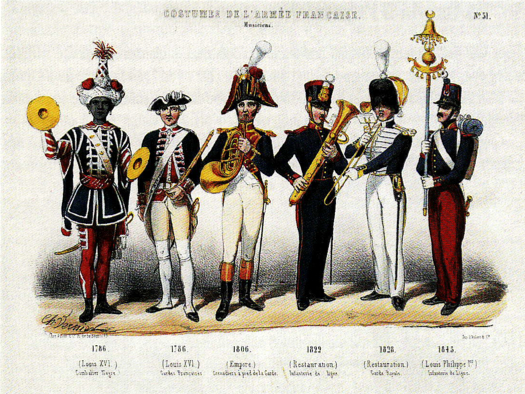
c. 1845—An illustration by M.A. Hayes depicting the 8th King’s Royal Irish Hussars, a cavalry regiment of the British Army, includes 2 trombonists on horseback (see below image; public domain).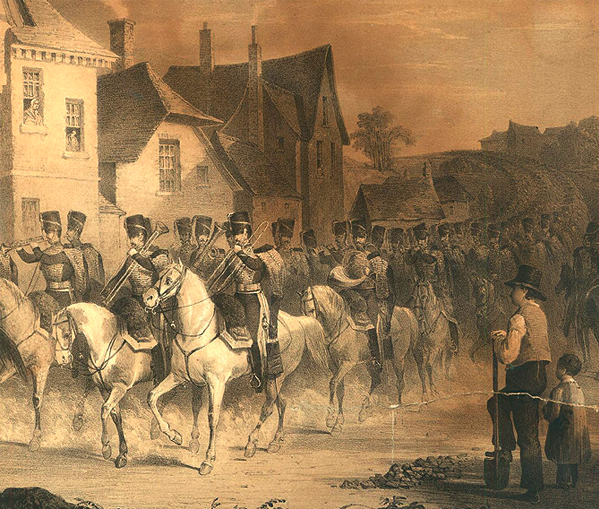
c. 1845—J. G. Kastner writes a method for trombone (Dudgeon 195).
1845—Prague, Czech Republic: A drawing satirizing the Prague music conservatory (Satira na prazské hudební konzervativce) includes 2 rear-facing trombones (see below image; public domain) (Volek, pl. 315).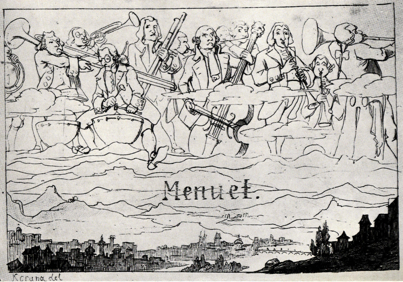
1845—Turin, Italy: The Teatro Regio contains 3 trombones (Herbert, Trombone 335).
1845—Muller writes a method for trombone (Dudgeon 195)
1845—Leipzig, Germany: Trombonist Franz Rex performs the David Concertino at the Gewandhaus. The review in Allgemeine musikalischeZeitung, comparing Rex with Carl Queisser,says, “Mr. Rex [was in a] difficult position [following Queisser] in the same composition Mr. David composed for him [Queisser]…he solved his difficult task, however, satisfactorily…” (Lewis, Gewandhaus).
1845—St. Florian, Austria: Anton Bruckner composes one of his early works, Missa ex g-moll pro quadragesima, of which only a sketch of the opening bars of the Kyrie survives. The scoring, which is for chorus, organ, and trombones, is a foreshadowing of Bruckner’s emphasis on trombone throughout his career. In the words of one historian, “The choice of instruments may well have been determined by the day for which the work was intended–the first Sunday of Lent. Bruckner may have wanted the sombre sound of the trombones to mark this serious occasion. However, it must also be noted that this scoring became a particular favourite of the composer” (Kinder 8).
1845—Berlioz conducts Félicien David’s Nonetto in F major (now lost) for 2 cornets a pistons, 4 cors a pistons, 2 trombones, and ophecleide. Antoine Dieppo, author of the method book Méthode complete pour le trombone (c. 1836) is one of the trombonists at the performance (Wallace, Brass Solo 240).
1845—Paris, France: A caricature by J.J. Grandville depicts Berlioz conducting a monstrous orchestra that includes a cannon and at least 7 trombones (see below image; public domain) (Hindley 252).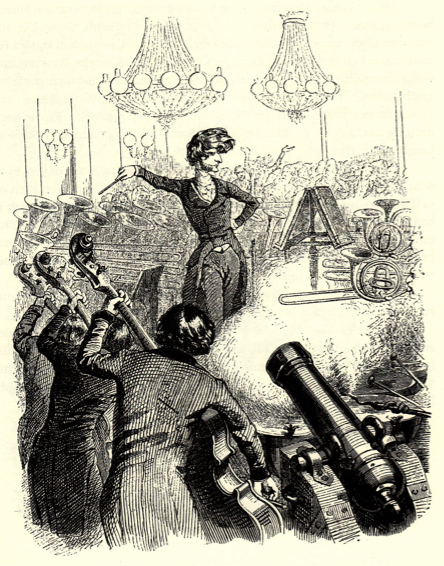
1845—Paris Conservatory morceau de concours: Antoine Guillaume Dieppo, Fantasie.
1845—Richard Wagner, Tannhauser.
1845—Rio de Janeiro, Brazil: Lithography firm Ludwig & Briggs publishes a print called Begging for the Holy Ghost, which includes a man playing a rear-facing trombone (see below image; public domain) (source: Google Arts & Culture, “Musica Brasilis”).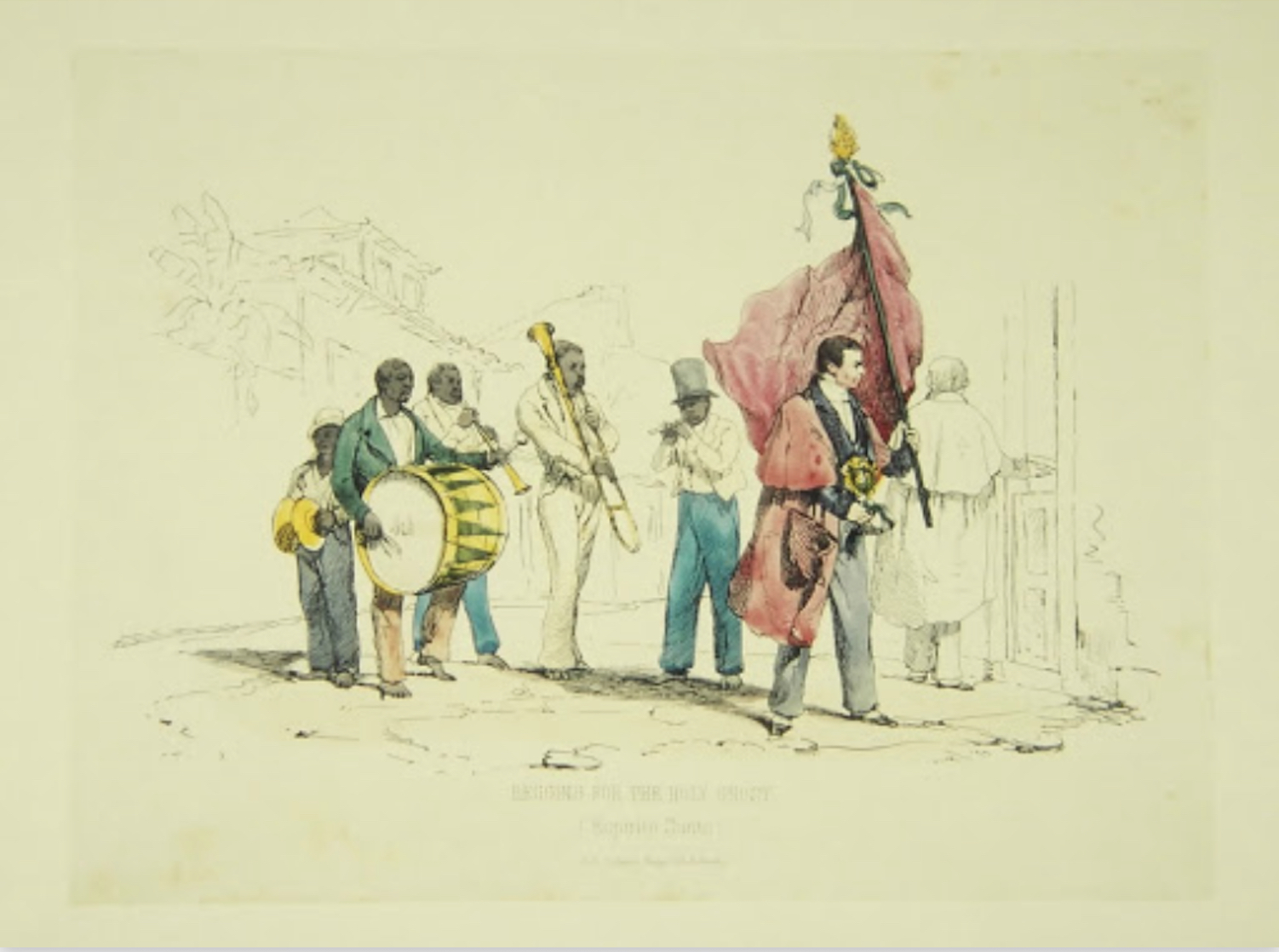
c. 1846—New Orleans/London: Trombonist Felippe Cioffi, who has been a well-known soloist in both New York and New Orleans, relocates to London (Guion, Four American).
1846—London, England: An image printed in the London Daily News depicts a “monster concert” staged by Louis Antoine Jullien at Covent Garden (see 2 details and full image below). The performing forces, comprised of Jullien’s orchestra and 4 military bands, include at least 7 trombones: 4 at the top of the first section of seating (see top detail, below), and 3–or possibly 4–on the third row of the steeper risers (see second detail, below) (public domain) (Remnant, Musical Instruments of the West 218).
1846—Paris Conservatory morceau de concours: Louis Stanislas Xavier Verroust, Solo.
1846—Hector Berlioz’s La Damnation de Faust includes an important trombone passage in the “Hungarian March” section.
1846—Hector Berlioz writes, “…there are eminent composers who are ignorant of the most rudimentary part of the science, the range of many of the instruments….Of the range of brass instruments and the trombone in particular they have only the most shadowy notion; you can see this from the way most modern scores, just as in the old days, cling to the middle register of these instruments and avoid taking them high or low, simply because the composer, not knowing their exact compass, is afraid of overstepping it” (Berlioz-Carnes 439).
1846—Robert Schumann’s Symphony No. 2 utilizes 3 trombones, including melodic material in the top voice.
1846—Leipzig, Germany: The death of trombonist Carl Queisser prompts a full-page obituary in the respected music periodical, Allgemeine musikalischeZeitung (Lewis, Gewandhaus).
1846-1847(?)—Paris, France: A lithograph by Henri Baron entitled Le pupitre de Palestrina, from the series Les Artistes contemporains, features a man holding a rear-facing trombone (see below image; public domain). For a nearly identical version of the image, only in reverse, published in the illustrated newspaper L’Illustration, see below, 1847.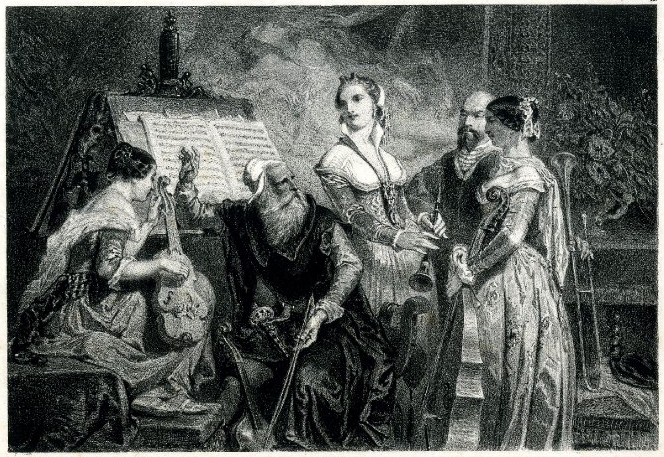
1846-48—Copenhagen, Denmark: Jørgen Sonne’s frieze, located on the outside of Thorvaldsens Museum, includes two panels that feature trombonists playing in boats in a brass band setting (see below lithograph from 1889, after original frieze; public domain image) (Henderson, Triumph 47).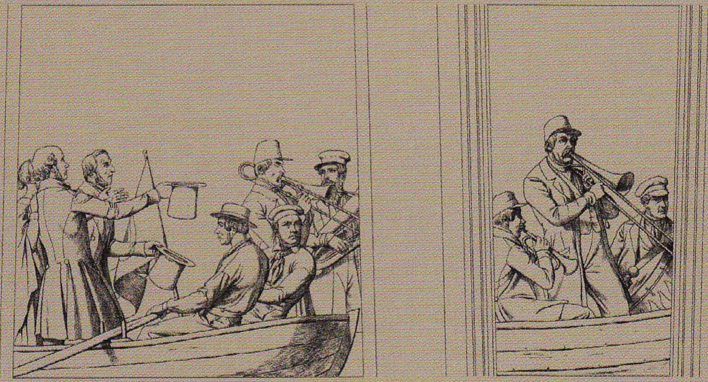
1847—London, England: There are 3 trombonists in the orchestra of the Covent Garden Theatre (Carse, Orchestra 490).
1847—St. Florian, Austria: Anton Bruckner composes his Zwei Aequale for trombone trio, motivated by the death of his godmother, Rosalie Mayrhofer. This specific work and similar music is performed at the outer gate of St. Florian’s monastery, where the dead are placed until a priest undertakes the consecration. Although only the first of the Bruckner’s two aequale can be precisely dated, it is generally assumed that they were written at the same time. The bass trombone part for the second aequali is lost but has been reconstructed by musicologist Hans Bauernfeind (Kinder 8).
1847—France: Gerard Grandville’s sketch, Parade de l’autruche, features a trombone, horn, and clarinet with conductor (see below image; public domain; Nancy, musée des beaux-arts).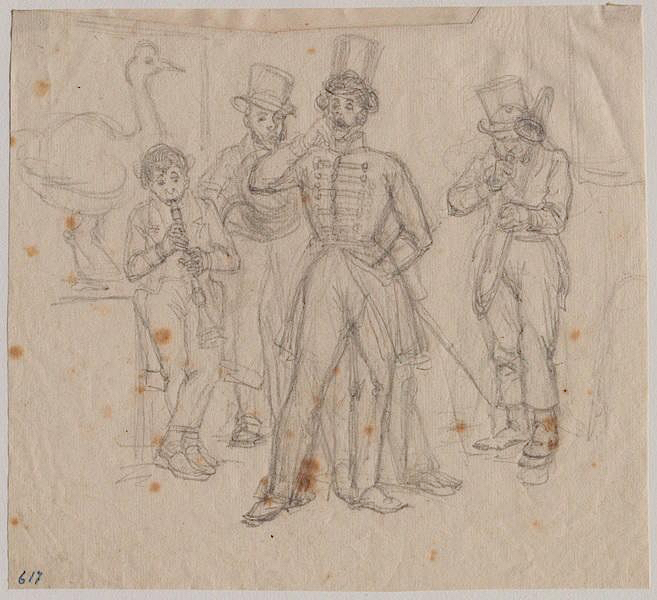
1847—England: A wood engraving depicts a group of Christmas carolers, including a trombonist (see below image; public domain).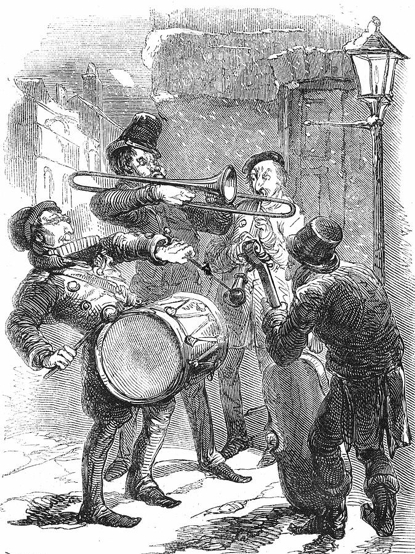
1847—Frankfurt, Germany: The Frankfurt Opera includes 3 trombones (Herbert, Trombone 335).
1847—Paris Conservatory morceau de concours: Louis Stanislas Xavier Verroust, Solo.
1847—Leipzig, Germany: Trombonist Moritz Nabich performs David Concertino at the Gewandhaus. The review in Allgemeine musikalischeZeitung says, “Mr. Nabich performed the Ferdinand David Concertino with great skill and a sure attack; however, (he had an) uneasy assignment following Mr. Queisser and he was occasionally flat, probably more out of embarrassment than a deficiency of refined hearing…and his tone was occasionally weak and covered. If he can, in the future, play out with more brilliance and strength, he would probably be on the same level with several [fine] trombonists, but not above any” (Lewis, Gewandhaus).
1847—Paris, France: An article in the periodical L’Illustration titled “Le Pupitre de Palestrina” (“The Desk of Palestrina”) is accompanied by an image by Henri Valentin that includes a rear-facing trombone in what appears to be an attempt at a historical representation of a Palestrina-era performance (see far left of below image; public domain) (L’Illustration, vol. 9, May 1, 1847, p. 137).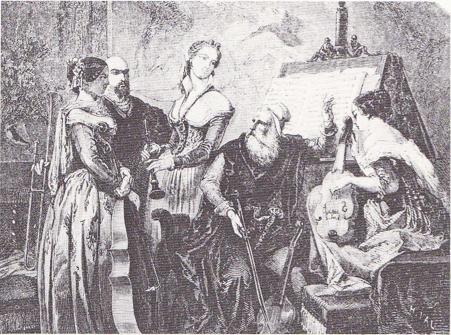
1847/8—London, England: Charles Dickens, in his novel Dombey & Son, describes several desperate musicians in search of employment for a bridal party, including a trombone player from a brass band: “The brass band…in the person of an artful trombone, lurks and dodges round the corner, waiting for some traitor-tradesman to reveal the place and hour of breakfast, for a bribe” (Lightwood 67).
1848—Germany: Jean Georges Kastner, in a listing of the typical instrumentation of the German cavalry bands of this time, specifies that bands include “3 trombones (alto, tenor, bass)” (Dudgeon, Keyed Bugle 38).
1848—England: Sir Michael Costa insists on the use of reverse bell trombones at the Sacred Harmonic Concerts in order to provide balance with the ensemble. As Anthony Baines puts it, “At this time apparently ‘overblowing’ and stridency were common among English players” (Baines, Brass 63).
1848—London, England: When Berlioz conducts his Symphonie funebre et triomphale, the extensive trombone solo in the 2nd movement is played by Koenig on alto trombone (Macdonald 229).
1848—London, England: A cartoon published in Punch magazine includes an aggressive trombonist among members of a band marching in the street (see below image, click to expand; public domain) (vol. XIV, p. 236).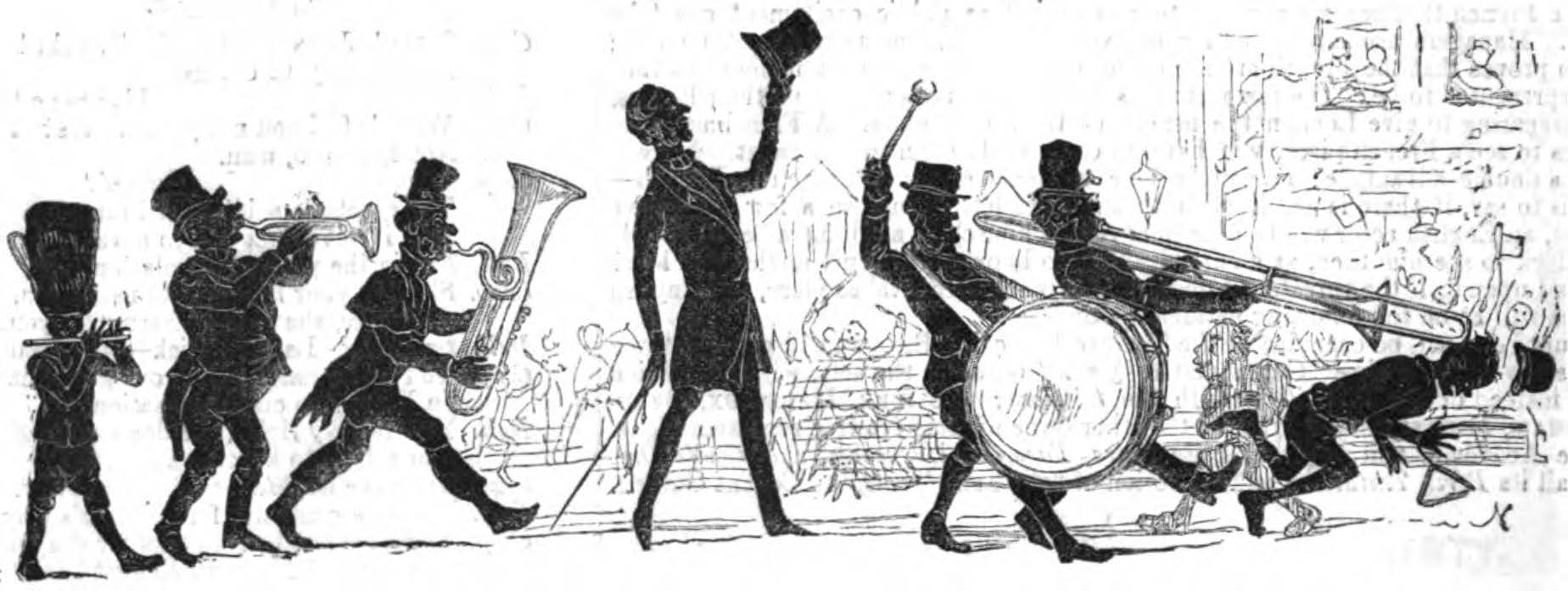
1848—Paris Conservatory morceau de concours: Louis Stanislas Xavier Verroust, Solo.
1848—Richard Wagner, Lohengrin.
1848—Paris, France: Georges Kastner’s treatise on military music, Manuel Général de Musique Militaire, includes prints of a number of different types of trombones used in military music, including rear-facing trombone, double-slide trombone, and several types of valve trombones (see below image; public domain). The note on the bottom of the page reads, “There are, as we know, three types of trombone, alto, tenor, and bass; but it is simply a difference in size and not in the shape of the instrument (Kastner, Militaire Pl. XVII).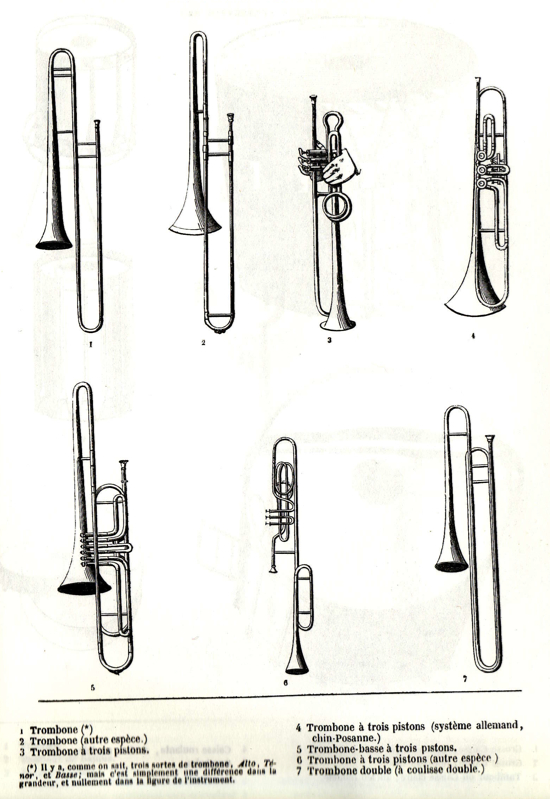
1849—Germany: The Hanover Court Opera contains 3 trombones (Herbert, Trombone 335).
1849—Claude Debussy, in a letter to G. Belloni, a Parisian well known in musical circles, gives the following satirical report about a performance of Wagner’s Parsifal under director Alfred Cortot: “Cortot, like Weingartner, leans affectionately over the first violins, murmuring intimate secrets; he swoops round to the trombones, adjuring them with an eloquent gesture, that might be translated: ‘Now my lads! Put some go into it! Try to be supertrombones!’ and the obedient trombones conscientiously do their best to swallow the brass tubes” (Kolodin, The Composer as Listener 106).
1849—London, England: A drawing in the British weekly magazine, Punch, includes a band with trombone, ophicleide, bass drum, and cymbals. The article attached to the image, titled A Prospect of Greenwich Fair, mentions “half-a-dozen different Bands playing as many Tunes” (May 29, 1849; see below image; public domain).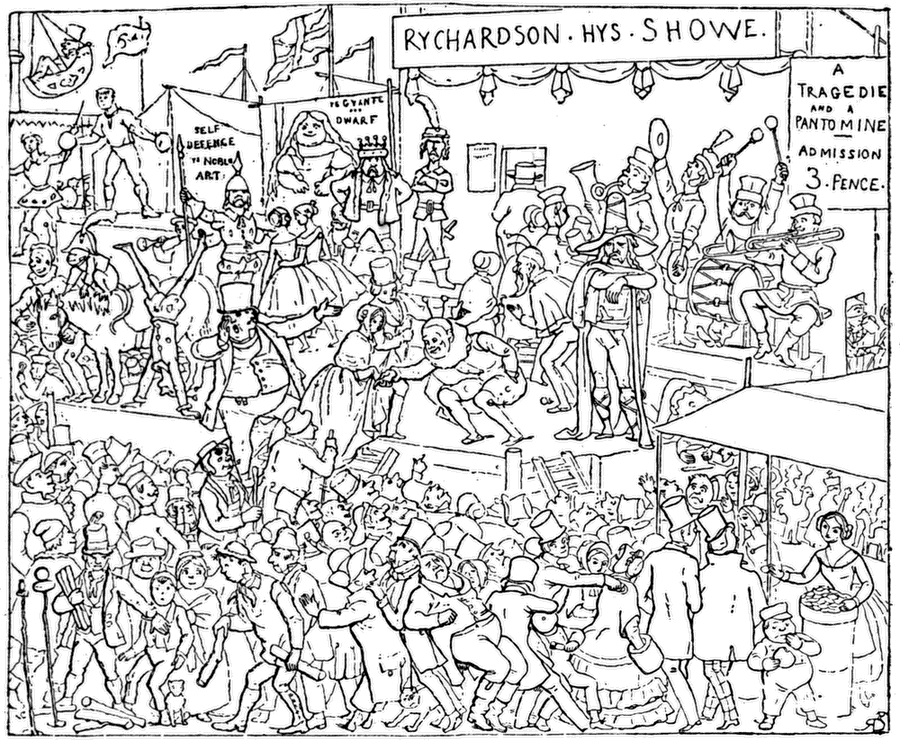
1849—London, England: A drawing in the British weekly magazine, Punch, accompanying an article titled “Kensyngton Gardens with ye Bande Playinge There,” includes trombone and ophicleide among the band. The article says, “The Tunes played mostly Polkas and Waltzes, though now and then a Piece of Musique of a better sort; but the Musique little more than an Excuse for a Number of People assembling to see and be seen (June 1, 1849; see below image; public domain).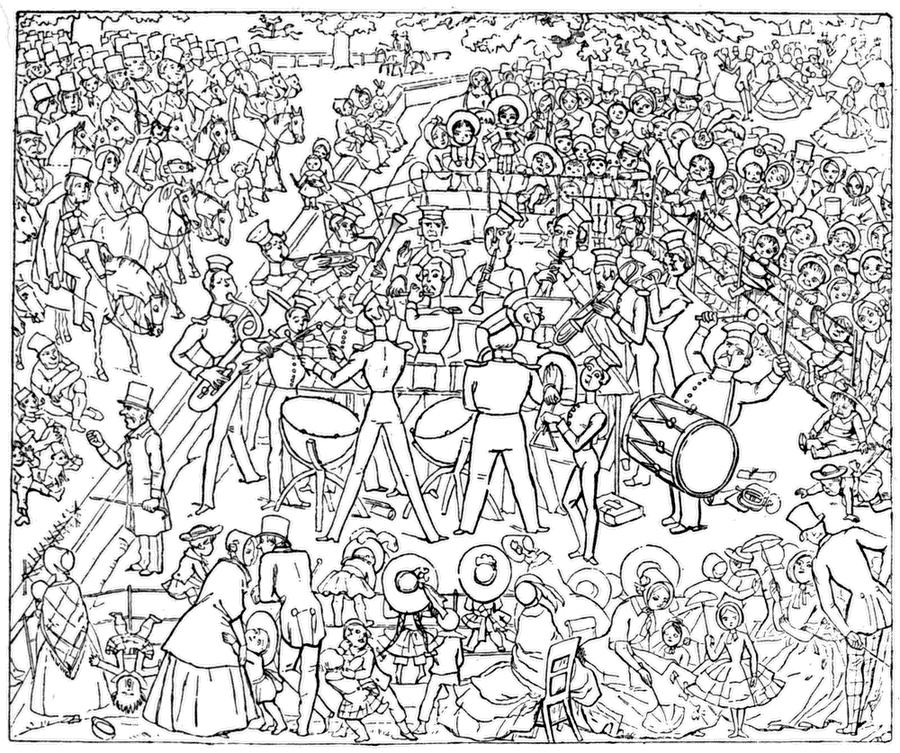
1849—London: England: A Promenade Concerte, one of 40 satirical drawings from Richard Doyle’s Manners and Customs of Ye Englyshe in 1849, depicts a large orchestra that includes trombone (see below image; public domain) (Doyle pl. 40). For a similar image, see 1846, above.
1849—Anton Bruckner writes his Requiem in D Minor in honor of his friend, Franz Seiler. The orchestra consists solely of strings and 3 trombones, with a horn briefly replacing one of the trombones in the Benedictus (Chase 251).
1849—Paris Conservatory morceau de concours: Louis Stanislas Xavier Verroust, Fantaisie.
1849—Bologna, Italy: A watercolor depicts a trombonist from the Bologna Civic Guard Band (see below image; public domain) (Istituto per la storia del Risorgimento italiano, Rome).
mid-1800s—Huge production of instructional material, including etudes by Edmond Vobaron, Antoine Dieppo, O. Blume, Friedrich Belcke, C. Kopprasch, and J. Friedheim, some of which are still in use today.
c. 1850—Freudenstadt, Germany: A relief on a vaulted rib in the Evangelische Stadtkirche portrays two decorative trombones and a banner/scroll. See below image; public domain (source: bildindex.de).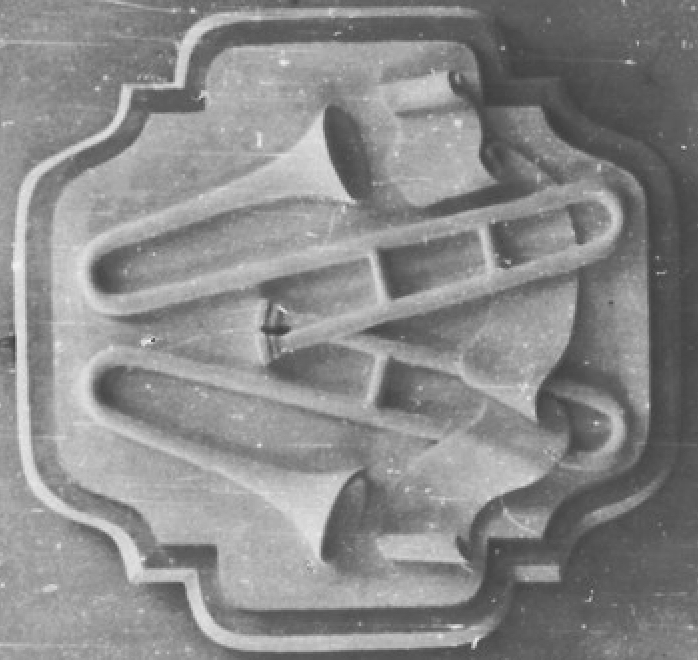
c. 1850—Bassano del Grappa, Italy: The firm Remondini publishes a print of military infantry and bandsmen. The band may represent Austro-Hungarians. Included among the band is a rear-facing trombone (see below detail; public domain) (Ryan 385).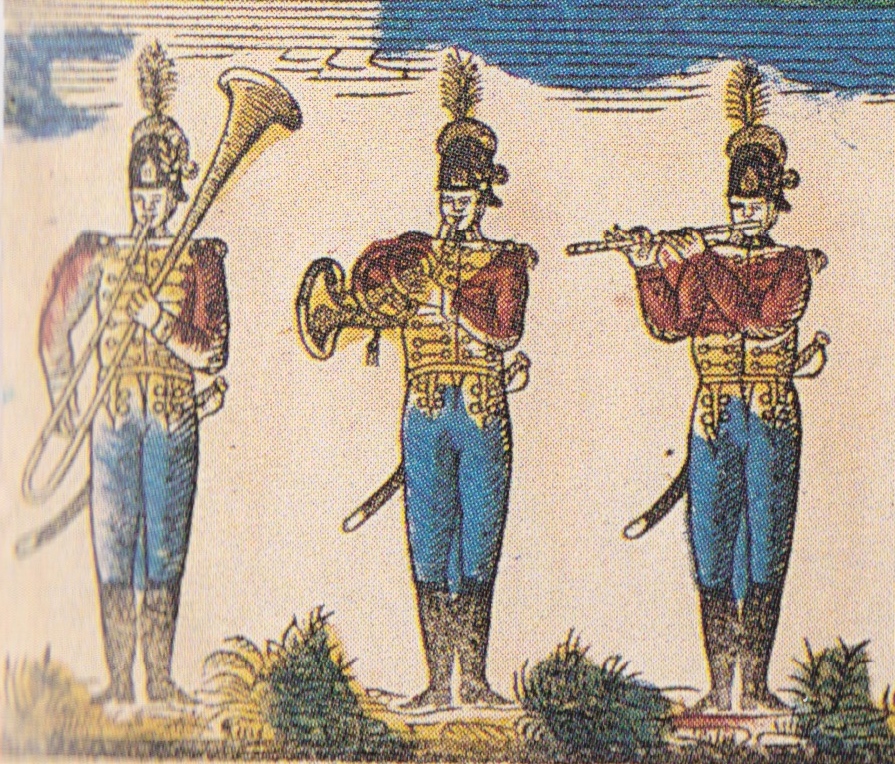
c. 1850—Turnhout, Belgium: Troupes de differentes nations, a print published by Brepols, probably copied from several slightly earlier prints by Pellerin, includes a depiction of French soldier on horseback playing a rear-facing trombone (see detail and full image below; public domain) (Ryan 440).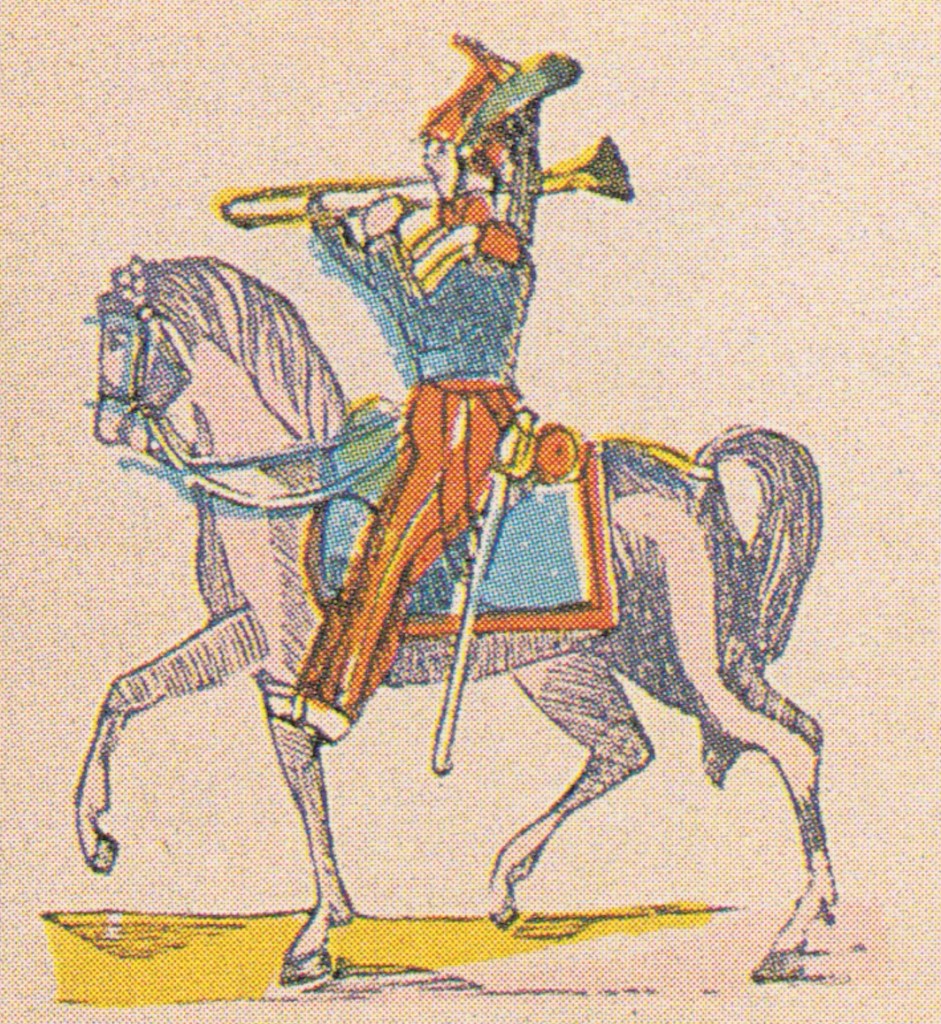
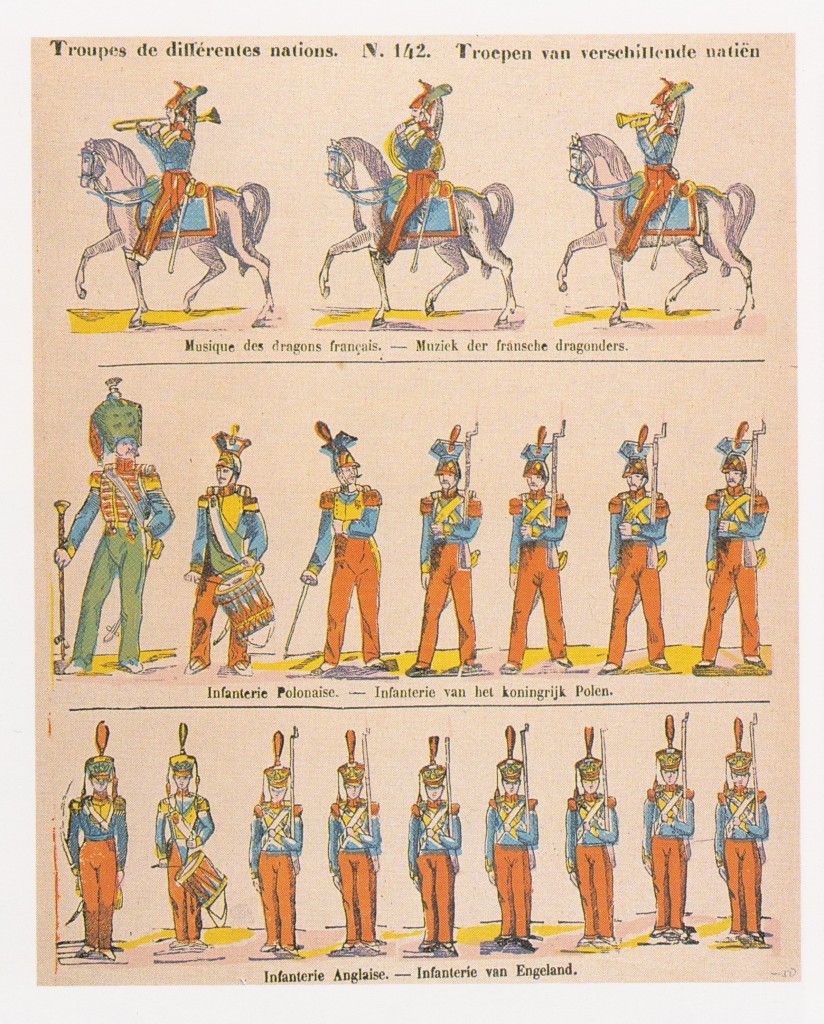
c. 1850—Use of large-bore tenors (essentially tenor built with bore and bell of an F bass trombone) begins in military bands. Composers such as Brahms write for large-bore instruments.
c. 1850—Large bass trombones in F or B-flat/F become the rule in German sections. Smaller bass trombone in G used in brass bands and orchestras in England for almost a century.
c. 1850—Russia: Symphony Concert in Russia, a lithograph by R. Babajev, includes a depiction of a trombonist performing in an orchestra. A violinist conducts the group with his bow (see below image; public domain) (Schwab 80).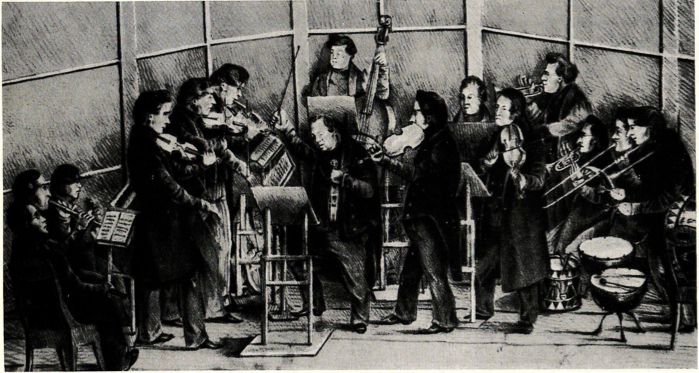
c. 1850—Brussels, Belgium: Musicien et trompette de cuirassiers, a lithograph by Henri Hendrickx, portrays a Belgian infantry musician playing on what may be a rear-facing trombone, the bell obscured by the player’s helmet (see below image; public domain) (Bibliotheque royale Albert I; Wangermée vol. 2, 263). For the color image, see New York Public Library Digital Gallery.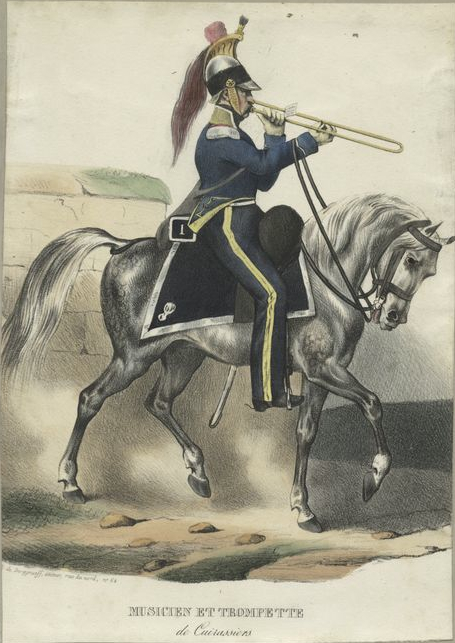
c. 1850—Trombones in B-flat with an F attachment appear briefly in France, where a piston valve rather than a rotary valve is used. Later, in the early 1900s, the B-flat/F concept takes root and flourishes (Baines, Brass 55).
c. 1850—Strasbourg, France: Rod Nicker publishes an illustration of an infantry band and sapeurs that includes two trombone players (see detail below; public domain) (Ryan 25).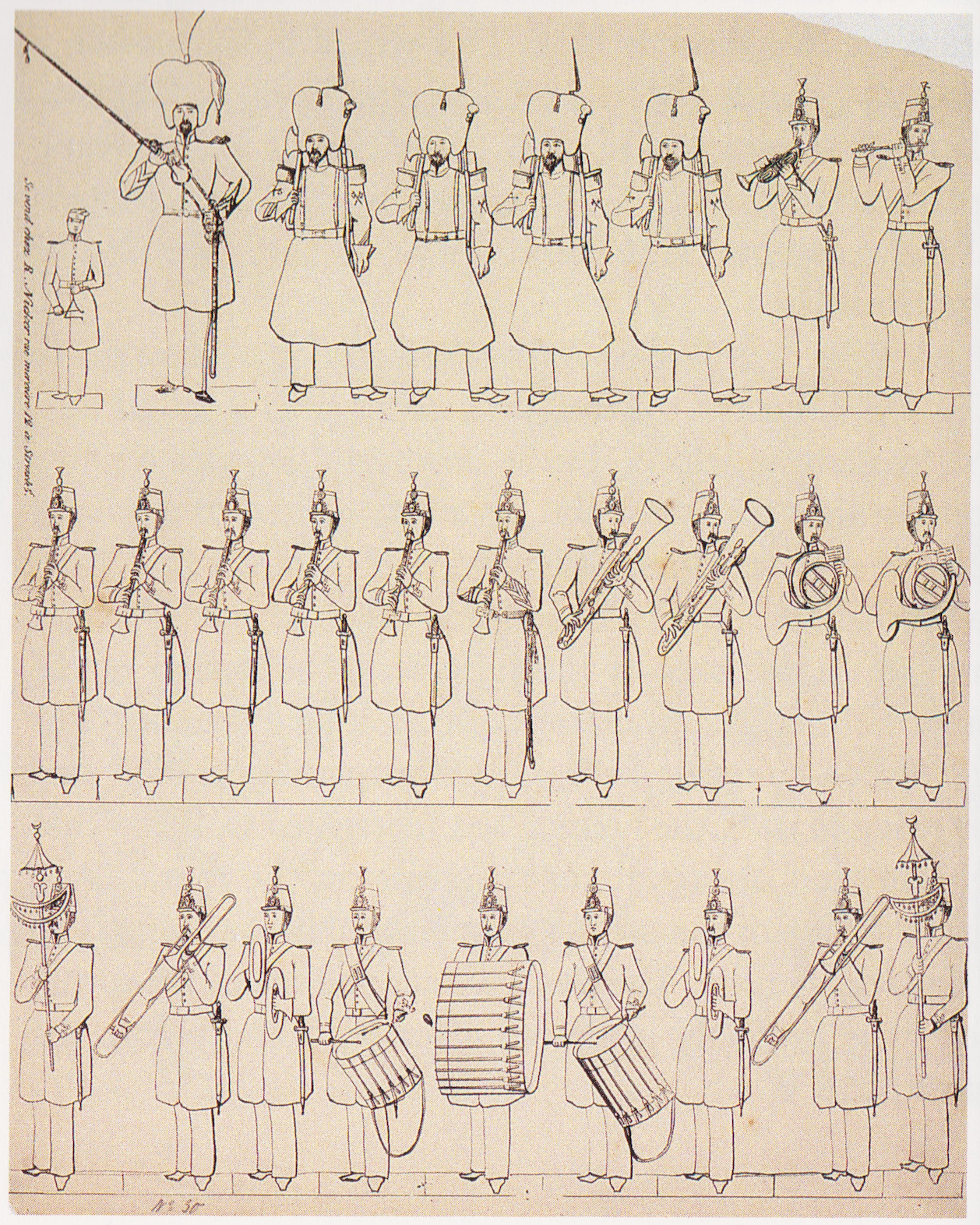
c. 1850—Anton Bruckner’s Psalm CXIV calls for 5 voices and 3 trombones. In addition, a manuscript fragment labeled Missa pro Quadragesima indicates a separate work scored for voices, organ, and trombones (Rasmussen, A Bibliography of Choral Music).
c. 1850—Austria: Artist Carl Schild depicts a group of youth in a street dance in his lithograph, Pannkooken-Musikanten. The brass quintet providing the music includes a trombone (see below image; public domain) (Salmen, Tanz im 19 56).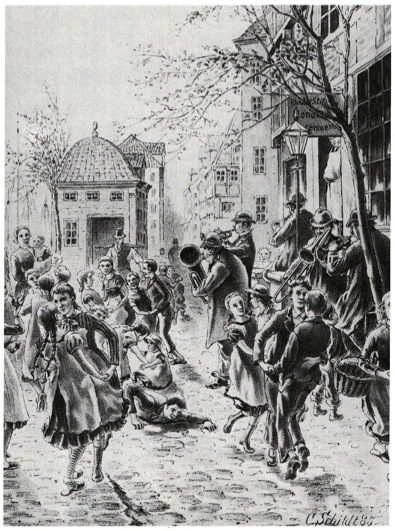 c. 1850—Bassano del Grappa, Italy: The firm Remondini publishes a print, probably representing an Austrian band, that includes a rear-facing trombone (see detail and full image below; public domain) (Ryan 382).
c. 1850—Bassano del Grappa, Italy: The firm Remondini publishes a print, probably representing an Austrian band, that includes a rear-facing trombone (see detail and full image below; public domain) (Ryan 382).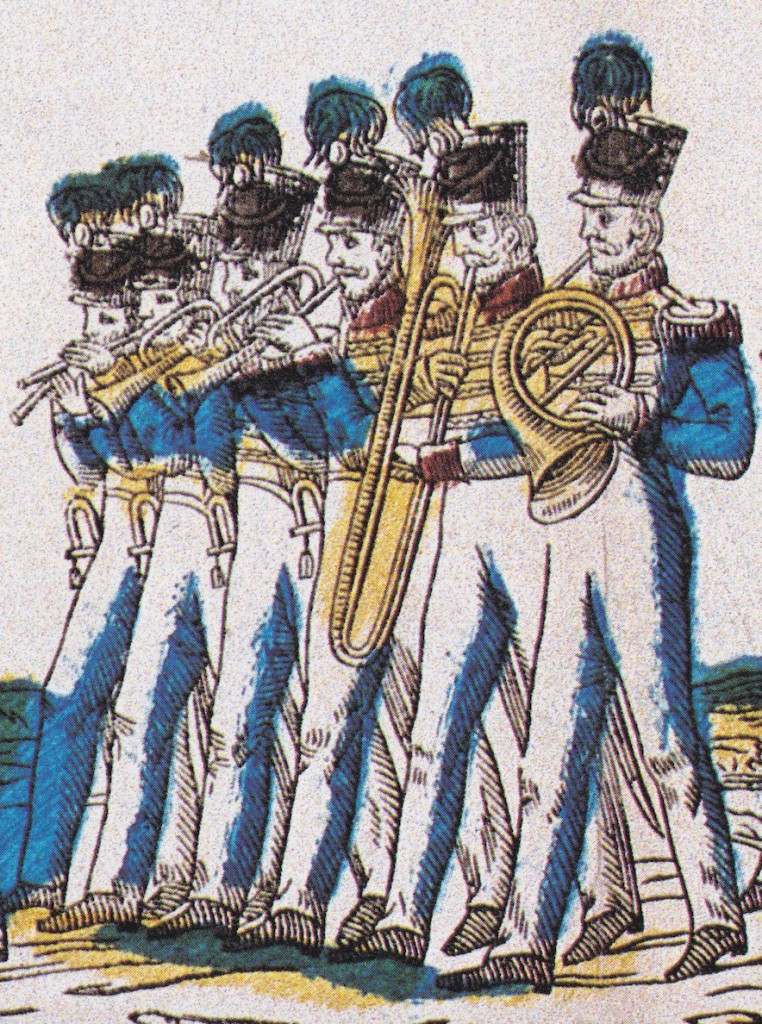
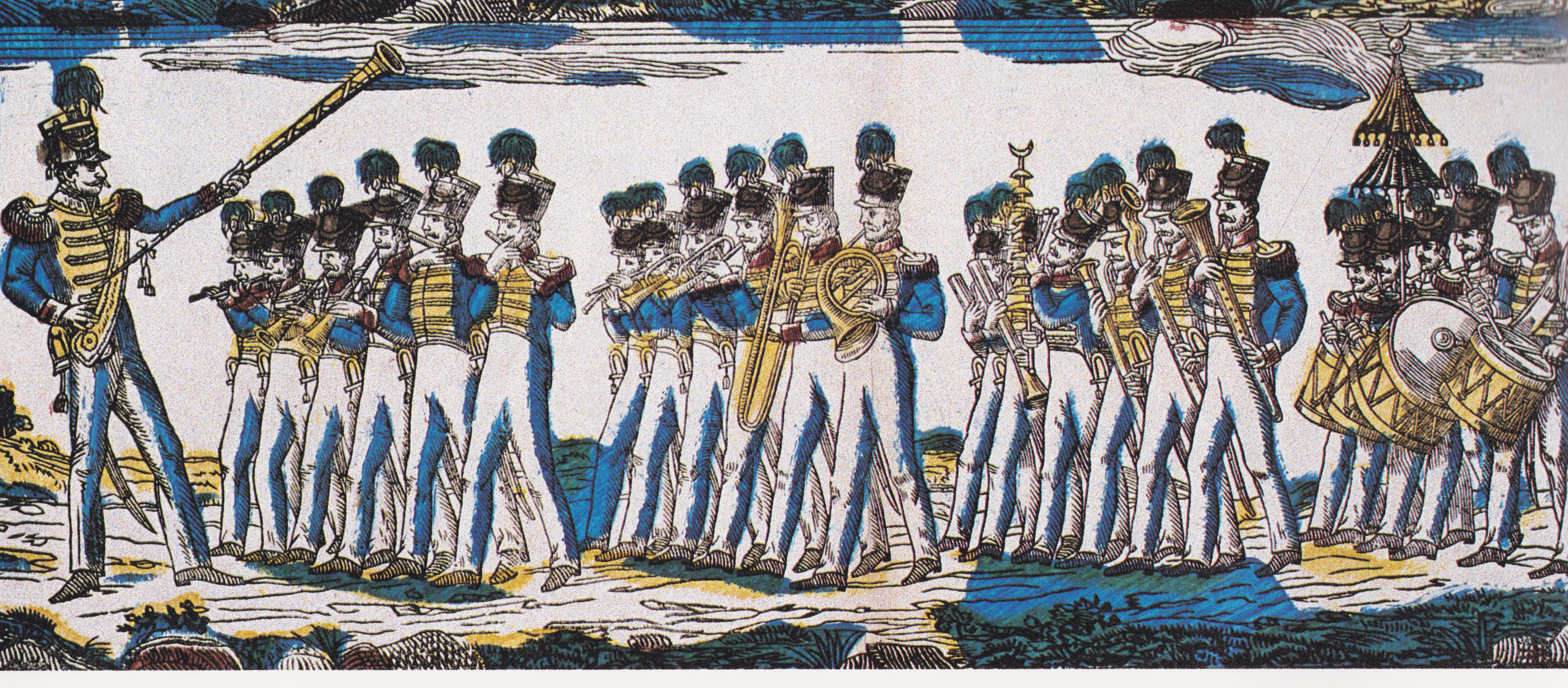
1850—Den Bosch, Netherlands: The pipe organ is built in Annakerk, or St. Anna parish church. Decorative trophies on each side of the organ pipes include what appear to be rear-facing trombones (see right detail, left detail, and full image below; special thanks to Iris Tjoonk).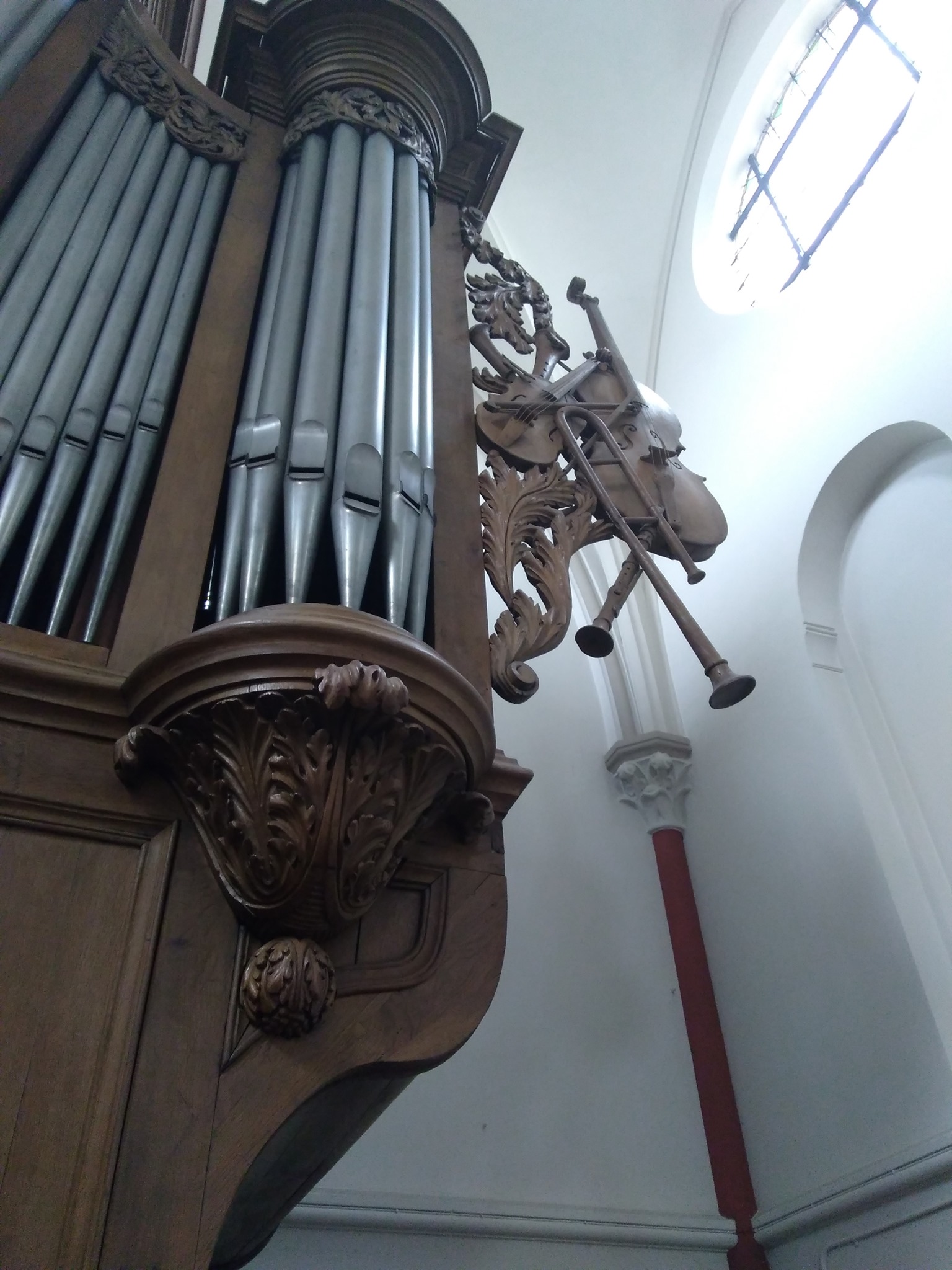
1850—Paris Conservatory morceau de concours: Louis Stanislas Xavier Verroust, Solo.
1850—London, England: 3 trombonists are included in the Grand National Concerts at Her Majesty’s Theatre (Carse, Orchestra 492).
1850—Paris, France: A lithograph accompanying Sigismond Stern’s Manuel élémentaire de musique includes depictions of “Lauréats du Conservatoire,” or the prizewinners of the conservatory, from the year 1849. Pictured are 6 brass players, including the trombonist in the below image (public domain) (Wangermée vol. 2, 192).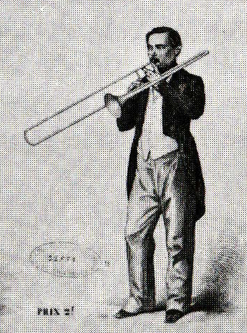
1850—London, England: A print from The Illustrated London News titled M. Jullien’s Concert at Drury-Lane Theatre depicts an orchestra with at least one trombone (see below image; public domain) (Illustrated London News, Nov. 23, 1850).